How To Sail Into the Wind (in 7 Simple Steps)
Sailing into the wind seems like Poseidon's magic, but once you learn how to set up your sails and hold the correct course, you can do it. This article explains the technique in 7 simple steps.
How to sail into the wind?
- Make sure your sails are close-hauled and tight
- Set your direction approximately 22 degrees from the direction of the apparent wind
- If you sail left from the direction of the apparent wind, your front sail should be on the left side and vice versa
- Your mainsail should be centered
- You can not sail directly into the wind, as there is an approximately 44 degree 'no go' zone' - 22 degrees from each side of the wind direction
- Because of that, if your destination is directly into the wind, zig-zag (tack) your way towards it, going 22 degrees left and then 22 degrees right
- During this zig-zag maneuver, you need to simultaneously change the boat's course and switch the front sail from one side to another
If you’re unsure what it all means, don’t worry. I will explain all the technical terms in the steps below.
It really isn't all that difficult once you remember these few steps. Plus it is a fun way to sail: the boat leans elegantly, the wind blows against you and you feel like the king of the seas.
So let's go through the steps in a bit more detail and make sure that next time you are out sailing, you can go wherever you set your mind to. Because that's what sailing is about - the freedom to do whatever you want.
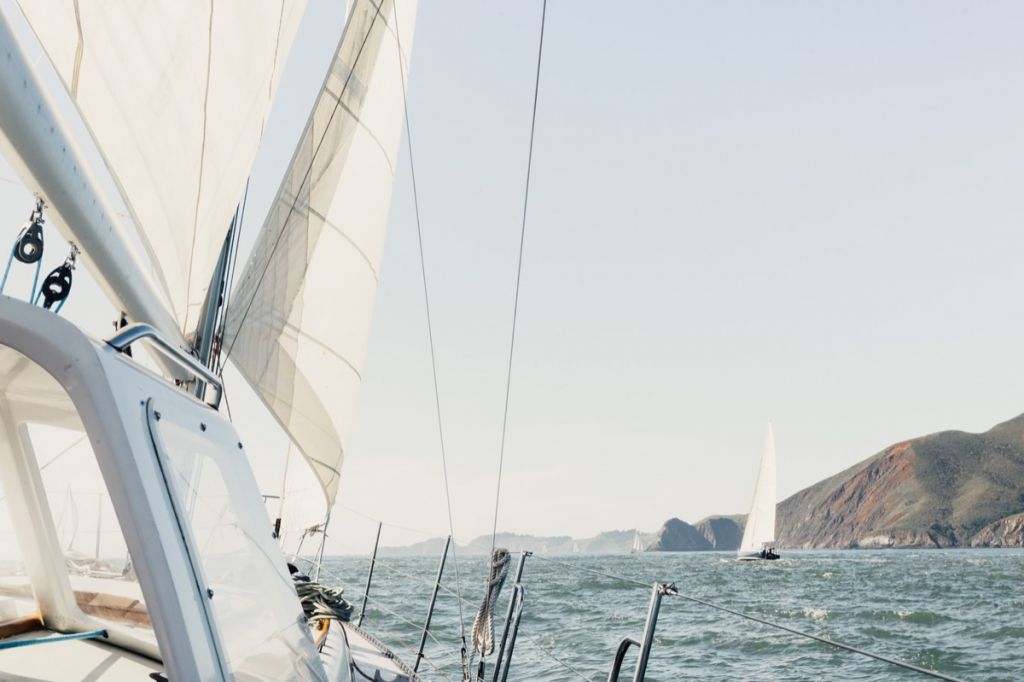

On this page:
Make sure your sails are tight, determining the right course, headsail position should be dead center, center your mainsail, avoid the no-go zone, zig zag (tack) to stay on course, how to tack to change direction.
When I was on a sailboat for the first time and the skipper said ‘we’ll now sail against the wind’, I thought he’d gone crazy. It’s a sailboat. It uses the wind to move. Things don’t go against the wind. They go with it. Look at the leaves on the ground when it gets windy.
But soon I was proven wrong. Because when sailing into the wind, your sail doesn't work like a sheet that is simply pushed by the wind. Rather, it works like an airplane wing. That is why sails of boats going against the wind have approximately the shape of a wing - and that's what step 1 is all about - making sure the sails are tight and hold their form. No flapping around, no loose ropes.
The sails should also be close-hauled. Close-hauled means they are pointing almost straight back. Their direction is mostly determined by how you set them, not by the wind.
I have a confession to make - you can't sail directly into the wind. That's just physically impossible. At least until somebody comes up with some new revolutionary sail system.
But here is the good news - you can have the next best thing - sailing almost into the wind. Precisely 22 degrees left or right from the direction of the apparent wind. Once you cross this imaginary line and steer your boat closer into the direction of the wind, your sails will start to flap around, lose their form and your boat will slow down.
Plus the boat will start shaking as the sails flap, it will all get noisy, simply put, you want to stick to those 22 degrees.
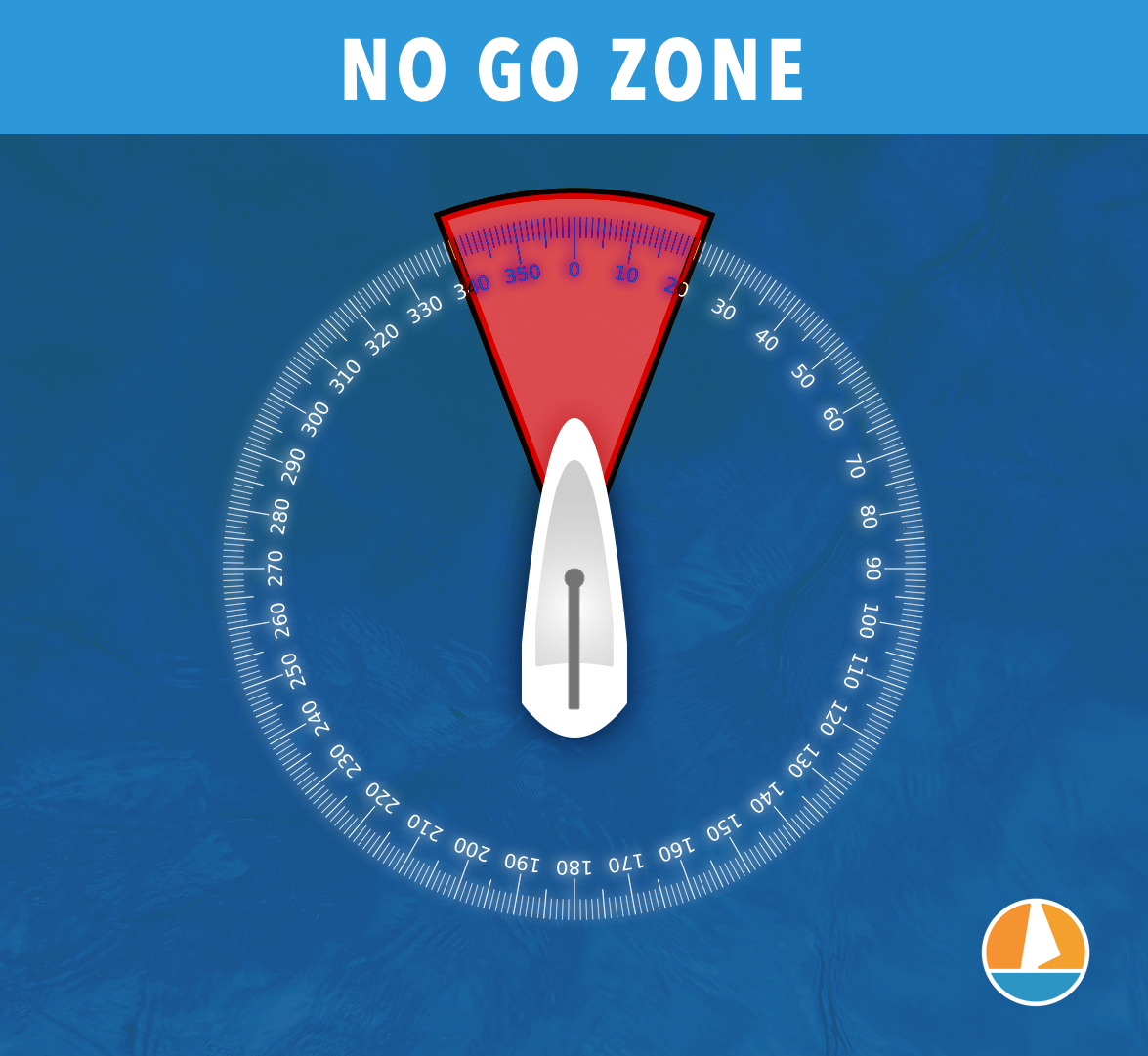
Don't worry, you don't have to bring a pen and paper to the helm and measure everything. The little V on the top of your mast along with the arrow that points into the wind, that's your best friend in determining the right direction. The angle of the V is precisely these 22 degrees times two.
So if the tail of the moving arrow overlaps one of the legs of the V, you are hitting the sweet spot.
If the tail is inside of the V, you are headed too much into the wind.
If the tail is too much outside of the V, you are still moving, but you aren't sailing as much into the wind as your boat allows.
The correct position of your mainsail is pretty clear. Have it tightly set right in the middle.
But what about your headsail? Your headsail is your front sail. This is mostly a jib. Even if it is as close-hauled as possible, you still have two places to put it - the left side and the right one. So what to do?
Well, the answer is pretty easy. If your sailing direction is left of the wind direction, you put the sail on the left. If you are sailing on the right side of the wind direction, you put the sail on the right.
Not much else to explain here. The tricky part comes when you need to switch sides. But more on that later.
As mentioned, the mainsail should rest in the middle. While sailing upwind, you don't need to manipulate it at all. That is unless you need to reef it during a storm. The important thing is to have it firmly set in one place. No wiggle room like would be the case if the wind was in your back. Remember, you are not being pushed, you are using your sails like wings.
All that needs to be said was covered in the second step. As already said, you can't go directly into the wind and some 22 degrees from its left or right side.
By the way, this number 22 is not exactly set in stone. It differs slightly for different boats. Racers can go more into the wind whereas cruisers have to keep the angle wider.
But you can find out what your boat's angle is quite easily. Close haul your sails, make them tight and start turning into the wind. As long as they hold the wing-shaped form, all is well. As soon as they start to flap, your angle became too narrow. You've entered the no go zone.
So right before the flapping starts, that's the sweet spot.
Obviously we have to address the important question here. What if your destination lies somewhere in the no go zone? Let's say the marina you want to rest at for the night is exactly where the wind is coming from. Dead center.
Well, since 22 degrees is the closest we can get to the wind direction, that's what we will do. Head left of your destination, sail for a bit, then turn and head right of your destination. Then left again, then right again. Dance around the center line and eventually you will get to your spot. If it sounds a bit abstract, see the picture below. This is called tacking.
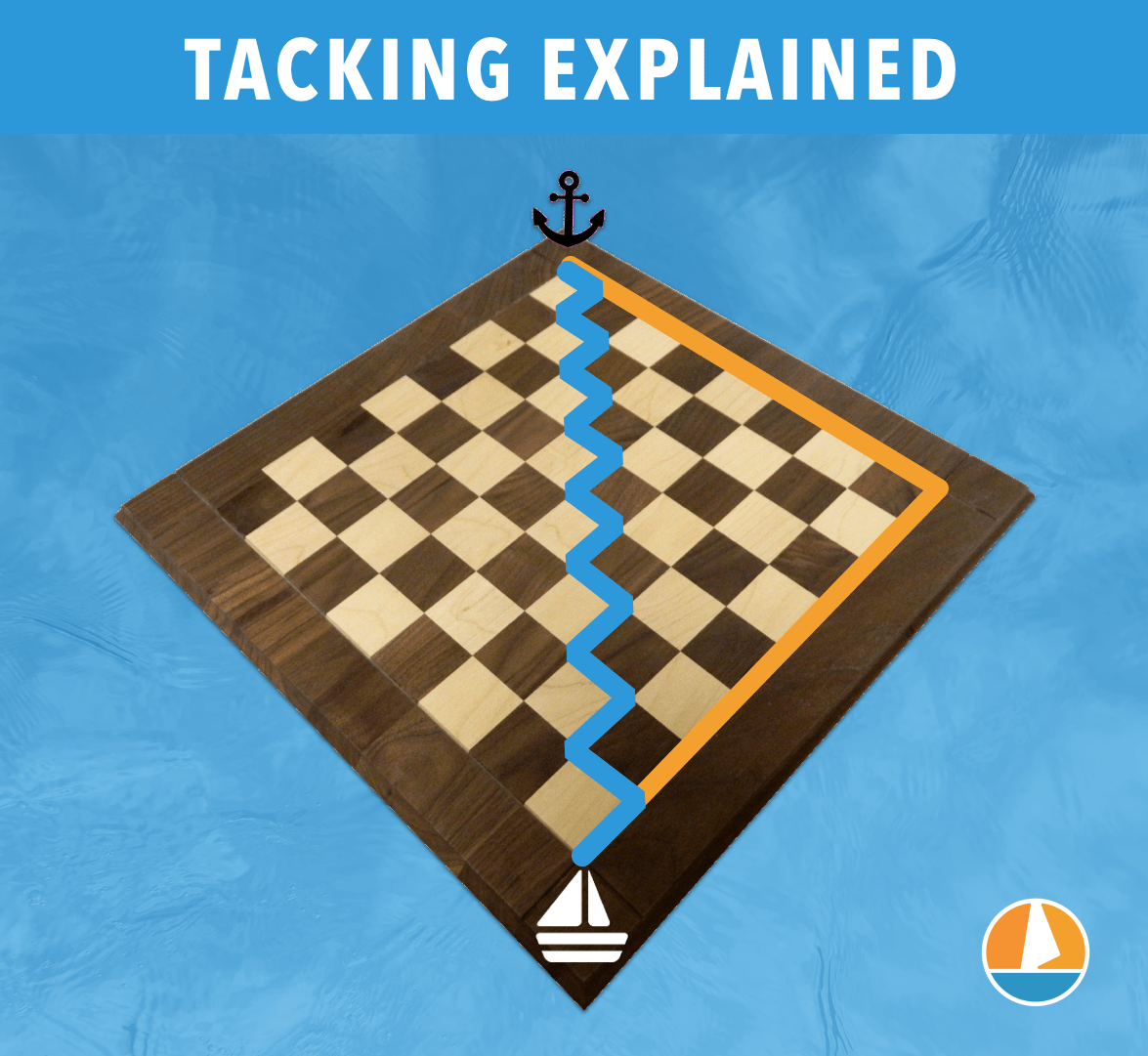
How often you turn is entirely up to you. Whether you decide to turn just once (the red line), making your passage wide but with less effort, or whether you turn every two minutes, making the passage narrow (the blue line), won't influence the total distance covered.
As portrayed in the picture, going all the way to the right corner, turning and going straight towards the finish, or turning every time you reach the end of a single field has no effect on how far your boat will have to go in total. You pass the same amount of chess fields.
But know that each turn slows your boat down a bit and it takes time before it gathers speed again. So as far as time and energy goes, better keep it simple.
This means that the route you take will mostly be dictated by how wide you can afford your passage to be. If you find yourself in a narrow channel, you will have to switch directions often, if on the other hand you have nothing but open seas ahead, you are in luck.
When planning your zig-zag route, keep in mind that the wind will make you drift. Your boat will not travel in a straight line ahead, it will be pushed by the wind wherever it will blow from. Even though you are travelling upwind, since you are going 22 degrees off the wind's course, the wind is still pushing you from one side.
This zig-zagging means you will have to change directions. Especially for beginners, this is a potentially challenging maneuver and oftentimes has to be done with at least two people.
The reason it is a bit tricky is that you have to change the boat's course and switch the front sail from one side to another simultaneously within the shortest time you can. Why the rush? You don't want to hesitate because, during the turn, the boat goes through the 'no go zone', the dead angle where it won't be propelled by the wind. You will rapidly start losing speed. So you want to make sure you are on the right course as soon as you can.
Also, in this dead angle, the sails will flap and you don't want to expose them to this much, especially if the winds are too rough.
The best way to go about this is to have one person at the helm and two more at winches. Once the helmsman starts changing the course, the winch holding the front sail on one side should be released and the front sail should be winched in onto the other side. There will be a lot of sail flapping, especially if it is windy, but don't worry and just keep winching the sail in until it is nice and tight again.
A Leaning Boat
Don't worry, no more steps. Just a quick heads up. If you travel upwind, your boat will lean to one side. The windier it is the more it will lean. This is completely normal. Don't correct the course just because the boat's belly starts peeking out of the waves. The wind itself can't tip the boat over. I won't go into the physics of why that is, just know you are safe.
But be sure to have all your cabinets closed and keep the number of things that can freely move around to a minimum. Many teacups have been broken like this. It is also nice to inform those onboard that the boat will lean, especially if they don't expect it.
Feel like a Poseidon
It is precisely the boat leaned to one side, oftentimes so much that you can touch the water while standing behind the helm, and the feeling of speed, that makes this type of sailing so fantastic. As both the wind and the waves will be coming towards you, the boat's speed will feel much higher than it is. This makes sailing exciting as you feel like you are flying through the waves.
As opposed to downwind sailing where you hardly feel any wind, since you are traveling with it.
Lift Explained (Ok, but how is all this possible?)
Right. I still haven't explained that. Well, as said in the beginning, you aren't being pushed by the wind, you are, as it were, being sucked into it. I know intuitively this makes little sense but if you bear with me through this little physics lesson, you'll understand it.
As mentioned, a tight sail on a boat going upwind has approximately the shape of an airplane wing. See the picture for illustration.

Because of this shape, the wind on the shorter side has to travel slightly slower speed than wind on the other side. This results in high pressure on one side and low pressure on the other. And as with anything, where there is low wind pressure, things are being sucked in. That's why the tight close-hauled sail is so important.
The reason why your boat doesn't just go sideways is your keel. It compensates for the suction by pushing the boat and the powers combined result in the boat going more or less forwards.
So there you go. The whole thing really is not that complicated. As with everything, go out there and practice a bit. The main things to get a feel for are keeping the correct angle so that you take advantage of the wind as much as possible and mastering the direction change. It is easier to practice in slower winds before you give it a full go.
Related questions
How to sail downwind? If the wind is in your back, you just open up the sails as much as you can and let yourself be pushed. Sometimes a spinnaker is used, which is a special balloon-like sail used in back winds. Sailing downwind is easier for many sailors as the whole thing is a bit more intuitive. So it is easier to set up the sails correctly.
How was this done in the olden days? The Chinese were able to sail upwind very early on. Some medieval European designs on the other hands were only able to take advantage of downwind. This then really depends on the particular designs. Just as with any technology, some cultures got the hang of it sooner than the others. One thing is for certain though, the ability to sail upwind is not a modern matter.
So take advantage of the ancient wisdom, get out there and enjoy!
Leave a comment
You may also like, how much do sailing lessons cost.
If you're new to sailing and want to learn the old-fashioned way, you need to take sailing lessons. But are they as expensive as people say? And what's a good deal?
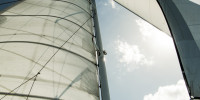
What is the Ideal Wind Speed for Sailing?

How Far Can You Sail In One Day?
Own your first boat within a year on any budget.
A sailboat doesn't have to be expensive if you know what you're doing. If you want to learn how to make your sailing dream reality within a year, leave your email and I'll send you free updates . I don't like spam - I will only send helpful content.
Ready to Own Your First Boat?
Just tell us the best email address to send your tips to:

How To Sail Against The Wind

Last Updated by
Daniel Wade
June 15, 2022
Efficiently being able to sail against the wind takes more practice and skill than any other sailing endeavor. Doing this well will enable you to sail anywhere.
Powered only by the wind, it seems intuitive that sailboats can easily travel with the wind behind them. However, when it is time to turn the other way and go home, it may seem impossible to sail home with the wind blowing straight against your boat.
Table of contents
But it is possible for this movement to become reversed because the sail of a moving sailboat is shaped like an airfoil like an airplane's wing.
When the air moves over the wing of a plane from the front and going backward, the wind that flows over the wing's top has to travel farther than the wind that flows beneath the bottom surface of the wing. This creates a difference in pressure to lift the airplane.
On sailboats, the wind that blows at an angle against the boat inflates the sail. It forms a foil shape similar to the airplane. It creates a pressure difference pushing the sail perpendicular to the direction of the wind.
Sailing Windward
The force from the foil shape of the sail is balanced and combined with other forces including the keep of the boat. The keel is the thin, long piece jutting down from the boat bottom.
From the water, the forces of drag simultaneous with wind pressure against the sail pushes the craft onwards. It moves at angles opposite the wind direction. in sailing terminology, this is called windward.
The keel is of particular importance because without its balance action. boats would drift simply downwind. Sailing windward won't work either if boats are directly pointed opposite the direction of the wind. Instead, the wind has to move against the boat at angles of about forty degrees for many sailboats.
When you angle your sailboat too sharply into the wind will cause the forces on the craft to become imbalanced. When this happens, the boat will then move sidewards into the water.
It is possible to sail against the wind when your sailboat's sail is slightly angled in a direction that is more forward than the force of the sail. The boat can then move forward in this aspect because the centerline or the keel of the boat does to the water what the sail is doing to the wind.
The sail's force keeps its balance by the keel's force. This keeps the boat from moving into the sail force's direction. A proper angle of attack moves the boat forward even if the total force of the sail is to the side when the boat sails into the wind.
In other words, when the sail is angled away from the hull's centerline, the more the force is pointing forward rather than pointing to the side. When you combine the forward force's slight adjustment with the water's opposition to the air, the boat can then shoot windward because you have found a way to sail a course of least resistance against the wind.
A sailboat sailing against the wind will turn through the point on each tack. This is the point in which the boat is neither on the starboard tack or the port tack and is directly headed against the wind.
On the other hand, boats are not able to sail directly against the wind. Thus, f a boat heads into the wind it is said to be "in irons" when it loses steerage. For this reason, a boat sailing against the wind is sailing with the sails trimmed tightly, also known as sailing "close-hauled."
When it comes to how to sail against the wind, keep in mind that when a sailboat sails too close to the wind, or with an angle too small to the wind, the term is called "pinching." This is also a phrase used in colloquial expression that means "recklessness."
To reach its target, sailors that intend to travel windward to a point in line with the exact wind direction will need to zig-zag in order to reach its destination. This technique is tacking. Sailors can reach a point in any direction using the technique of tacking and traveling at angles closest to the wind direction.
Sailing against the wind in practice is usually achieved at a course of and angle of around forty-five degrees to the oncoming wind. To reach specific points, alternating the wind's direction between the starboard and the port is sometimes necessary. The term for this is "tacking."
Tacking is when a yacht or a sailboat sail against the wind. Counterintuitively, this means that compared to having a weak wind behind you, it is always better to have the strong wind in the direction opposite your craft. Having no wind is the worst-case scenario. Think of vectors.
The wind generates forces against the boat's hull through the momentum change that the sails cause. The force goes both towards the direction of where you are going and perpendicular to the motion. The keel takes up the perpendicular force and leans the yacht. Motion is then created by the remaining forward vector.
If your destination is located upwind, how are you going to sail there? Because of the lift created by wind blowing across and not against them, the sails propel the boat forward. This happens unless the wind blows from directly over the back of the boat (astern).
As you begin steering in the direction of the wind, you trim the sails tighter in and keep them full, so that lift is continuously generated. However, sailing too close to the sail and wind will "luff."
This means the edge of the forward sail begins to flutter inwards and outwards and the boat slows down. If you begin turning more into the wind, the whole sail will soon be flapping like a king-sized bedsheet you hung out to dry.
However, don't stop turning into the wind and you will soon see the sail filling on the other side of the boat. This is called tacking and the scientific reasons are explained as you read further down.
Sailboats made today can sail up to around a forty-five-degree angle against the wind. For example, if the north wind is blowing into your sail, the boat can sail on a port tack about the northeast.
The boat can sail all the way through to northwest, west, south, and east on the starboard tack, or wind coming from the boat's right side. Port tack means that the wind comes over the left side of the port. Tack means which side of the boat the wind blows from.
Even if you can't sail your boat literally directly into the wind, sailors call this tacking or beating to windward. You will find that on the newer tack, you sail in the direction that's at about right angles to the old tack. This occurs with the wind still at about forty-five degrees but this time on the other side. The zig-zagging and the repeated tack will move the boat upwind.
You can learn more about tacking a sailboat here .
Four Forces
Four forces act on a sailboat trying to sail against the wind. The two that directly affect the boat are the viscosity force of the water and the force of the wind, which propels the boat.
The water's viscosity slows down the boat and helps her keep on-course. The remaining two forces are buoyancy and gravity. Buoyancy pulls up the sailboat and gravity pulls her down. All of these forces keep the boat afloat as it sails against the wind.
The combined effect of the water and the wind is a net force pushing the boat diagonally against the wind. The resistance of the water combined with the force of the wind determines the direction in which a sailboat sails. On the sail, the force exerted by the wind has two components:
- The lift component pushing the sail into the wind perpendicularly.
- The drag component pushing the sail into the direction of the wind.
Because of the lift, the direction of the wind-force varies from the direction in which the wind blows. The angle between the wind and the sail shape of the sail will determine what direction the wind force goes.
The forward motion of the boat and her slippage sidewise slows down due to water resistance. For boats to sail against the wind diagonally, the sidewise slippage needs to be minimal compared to the motion forward. Sidewise slippage is significantly reduced with the keel.
If a keel somewhat eliminates the sidewise slippage, sailboats can only move in the keel's direction. This is also the direction of the sailboat's centerline. Whenever the wind-force total diagonally points forward in relation to the keel, the boat will then move forward in the keel's direction.
If the keel is pointing diagonally into the wind, and the wind-force diagonally points forwards, the boat will then diagonally sail into the wind.
On the other hand, the boat won't be able to diagonally sail into the wind if the sidewise slippage is too big. Just like everything else, sailing against the wind takes practice. Master this and you can sail yourself anywhere in the world and through anything.
Related Articles
I've personally had thousands of questions about sailing and sailboats over the years. As I learn and experience sailing, and the community, I share the answers that work and make sense to me, here on Life of Sailing.
by this author
How to Sail
Most Recent

What Does "Sailing By The Lee" Mean?
October 3, 2023

The Best Sailing Schools And Programs: Reviews & Ratings
September 26, 2023
Important Legal Info
Lifeofsailing.com is a participant in the Amazon Services LLC Associates Program, an affiliate advertising program designed to provide a means for sites to earn advertising fees by advertising and linking to Amazon. This site also participates in other affiliate programs and is compensated for referring traffic and business to these companies.
Similar Posts

How To Choose The Right Sailing Instructor
August 16, 2023

How To Sail From California To Tahiti
July 4, 2023

How To Tow A Skier Behind A Boat
May 24, 2023
Popular Posts

Best Liveaboard Catamaran Sailboats
December 28, 2023

Can a Novice Sail Around the World?
Elizabeth O'Malley

4 Best Electric Outboard Motors

How Long Did It Take The Vikings To Sail To England?

10 Best Sailboat Brands (And Why)
December 20, 2023

7 Best Places To Liveaboard A Sailboat
Get the best sailing content.
Top Rated Posts
Lifeofsailing.com is a participant in the Amazon Services LLC Associates Program, an affiliate advertising program designed to provide a means for sites to earn advertising fees by advertising and linking to Amazon. This site also participates in other affiliate programs and is compensated for referring traffic and business to these companies. (866) 342-SAIL
© 2024 Life of Sailing Email: [email protected] Address: 11816 Inwood Rd #3024 Dallas, TX 75244 Disclaimer Privacy Policy

My Cruiser Life Magazine
How to Sail Into the Wind – Tacking a Sailboat
One of the first sailing fundamentals you learn with you’re new to the world of sailing is the idea of sailing a boat into the wind. Sailboats can sail in the direction of the wind, but they do so by making a zig zag course made up of a series of maneuvers called tacks.
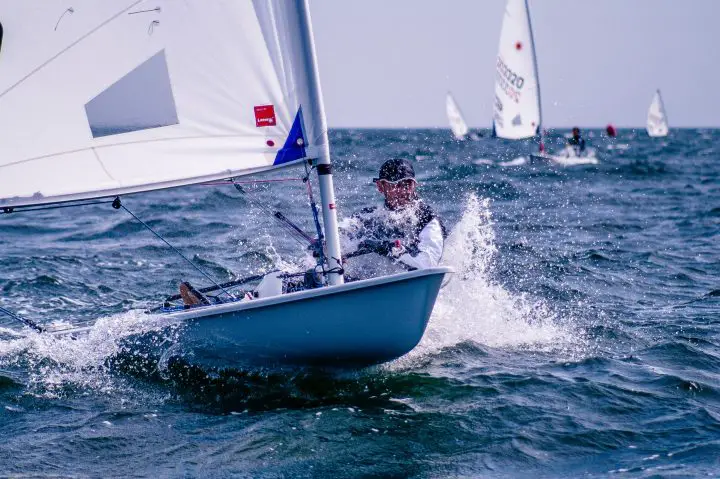
Table of Contents
Why does a sailboat tack, what is a tack of a sail, what are the points of sail depending on the wind direction, what’s the difference between a port or starboard tack, what’s the difference between a tack and a jibe (gybe), how to tack a sailboat – step by step, how to tack in sailing kept simple, faqs (frequently asked questions).
Tack is a confusing word because it’s used in various ways on a sailboat. Depending on its usage, it can be either a noun or a verb.
First, as a noun, a tack is a maneuver that a sailboat makes when it turns in the direction of the wind blows. For example, a boat may be sailing on a port tack, with the wind coming from the left side of the boat. After the boat tacks—which in this case would be a turn to the left—the boat will be on a starboard tack, with the wind coming from the right-hand side.
As a verb, a skipper might yell, “Ready to tack!” to their crew to let them know that the boat is about to tack. An alternative command is “Ready about!”
Since a sailboat cannot sail directly into the wind, a boat makes a zig-zag course over the water to go in that direction. The zig-zag course is made up of a series of tacks.
The word “tack” has a second, entirely different definition on a sailboat, too. When discussing the parts of a sail, the tack is the lower rear corner of a triangular sail. So, the tack of a mainsail is the end attached at the back of the boom. The tack of a foresail, like a jib, is the one that you attach the jib sheets to.
The other two corners of sail are the head (at the top) and the clew (at the forward edge). The edges of sail are called the leech, luff, and foot. So more specifically, the tack is the corner where the leech and the foot meet.
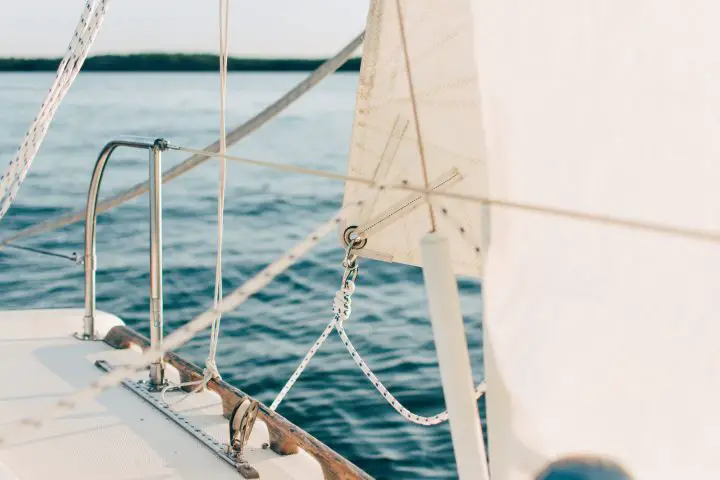
Sailboats can sail in nearly any direction except directly into the wind. Each direction has a different name and is known as a point of sail .
Sailors measure their angle to the wind based on the apparent wind angle (AWA). The AWA is simply the number of degrees from the bow that the wind is located. If a boat is headed dead into the wind, the AWA is 0 degrees. If the boat is headed dead downwind, the AWA is 180 degrees. Neither of these directions is optimal, so normal sailing occurs between 45 and 160 degrees AWA.
- Close Hauled — A boat that is as close to sailing upwind as it can is said to be “close-hauled.” In this scenario, the sails are tightly sheeted, and monohulls will be healed over. The AWA that a boat can sail depends on its design. Most boats cannot sail closer than 45 degrees to the wind. Colloquially sailors call sailing close-hauled “beating.”
- Close Reaching — A bit “farther off the wind,” and the boat will be close reaching. This is usually between 60 and 90 degrees AWA.
- Reaching — A boat is reaching when it is precisely 90 degrees AWA. This is actually the fastest point of sail for most boats.
- Broad Reaching — If a boat is reaching, but the wind is behind the beam, it is on a broad reach. This occurs between 90 and 120 degrees AWA.
- Running — When a boat is on a run, it is sailing downwind. In this situation, the sails act less like airplane wings generating lift and more like leaves blowing over the water.
- Wing-on-Wing — Wing-on-wing is a sailing maneuver, not a point of sail. But it occurs when a boat is more or less sailing dead downwind (180 degrees AWA). When a boat is wing-on-wing, one sail is on a starboard tack, and the other is on a port tack.
How Does a Sailboat Sail Into the Wind?
Contrary to what many people think, modern sailboats can sail in the direction of the wind . In fact, they can sail in nearly every direction relative to the wind except one. But they cannot sail directly into the wind. So if the wind blowing on the water today is out of the direction of your desired course, you’ll have to tack back and forth to get there.
For the sail to work, it needs to have air pushing on one side of it. If the boat is pointed directly into the wind, the sails will flap like flags on a pole. When this happens, the boat is said to be “in irons” and will eventually come to a stop.
How close to the wind a boat can sail depends on its design. Racing sailboats can do the best and generally sail within 30 degrees of the wind. However, cruising boats usually fall somewhere in the 45 to 60-degree range due to their wider beams and shallower keels.
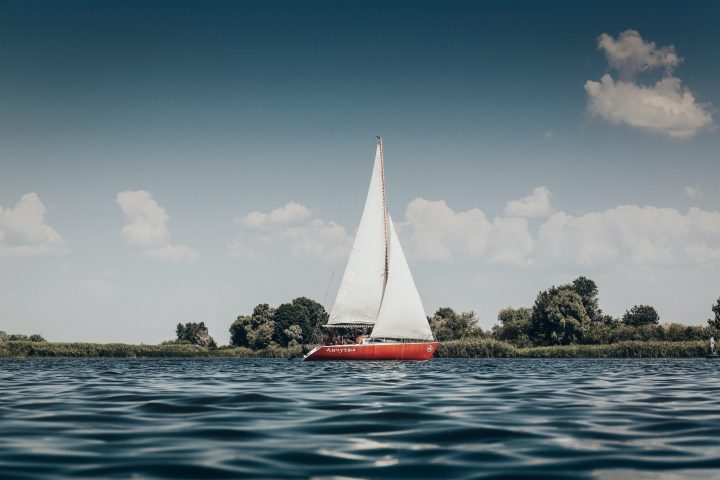
The boat’s direction is always described in terms of the wind for a sailor. As such, one of the most fundamental terms in sailing is which tack a sailboat might be on. A port tack describes a boat with the wind coming over the port railing, so the sails are on the boat’s starboard side. Conversely, a boat on a starboard tack has the wind over that rail and the sails on the port side.
Describing which tack a boat is on is vital in racing and right of way rules. Rule 12 of the COLREGs , the internationally agreed-upon rules that govern shipping, says that when two sailing vessels meet, the vessel on the starboard tack has the right of way.
If a tack has an opposite maneuver, it is likely a jibe, which is sometimes spelled “gybe.”
A jibe occurs when sailing downwind. For example, if a boat is running on a port tack and wants to switch to the opposite tack, they could go the long way around and tack through the wind, or they could sail through dead downwind. Passing dead downwind so that the sails switch is called a jibe.
Jibes are more dangerous maneuvers that tacks for a few reasons. A planned jibe that is well executed is perfectly safe, but the force of the boom passing over the boat can be significant. All crew should know that the jibe is occurring and duck down to avoid getting smacked by the boom.
An accidental jibe, which isn’t planned, can be catastrophic. The force of the boom crashing over the boat can be immense if the winds are strong. It can easily tear the sail, and brake lines or damage the boom or gooseneck fittings.
You should always take jibes slowly and carefully. The stronger the winds, the more careful you should be. When tacking, the crew’s attention is focused on the jib sheets, but in a jibe, the crew must pay close attention to the mainsail and boom. The jib will usually be blanketed by the wind and easy to control when sailing so deeply downwind, so the jib sheet will be easy to manage.
Anytime a jibe is imminent, be it purposeful or accidentally, the skipper shouts, “Jibe ho!” This is to let everyone know to be ready for the maneuver—or at least to get out of the way of the boom. In light wind, it is usually a nonevent, but care should be taken regardless.
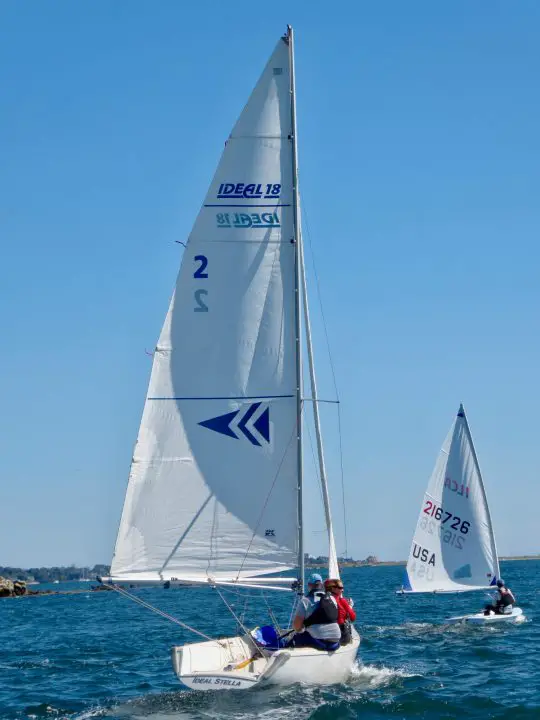
How to tack a boat depends on the boat and how it’s set up. First, the boat is sailed close-hauled on the standard modern sloop with both sails sheeted in tight. With the mainsail brought in, it will be self-tending on its boom.
So besides turning the wheel, the crew needs to only worry about the jib. The crew will watch the jib as the skipper turns the boat and brings the helm about. When the sail begins to luff or flap, the crew will release the working sheet from its winch and start to bring in the lazy jib sheet on the other side of the boat.
The slacker you can take out of the line, the tighter the tack. Once the slack is out and the line secured on the drum, you can bring the sail in with the help of the winch handle.
The boat speed at which the crew works to switch the sheet depends greatly on the sort of sailing you’re doing. If it’s a solo skipping working alone with only the help of the sailboat autopilot , the emphasis is on making the tacking maneuver easy and safe. This means taking it slow and not rushing anything.
On the other hand, if the crew is prepping for a race, boat speed is of the essence. So they’ll want to pull off the tacking maneuver perfectly in sync. A sloppy tack means that the boat will slow down unnecessarily, and recovering from it may mean losing a little ground by sailing on a reach while the boat builds up boat speed again.
A good skipper will work out how to tack with their crew in advance. Tacking involves good communication and teamwork on a boat with more than one person. Cruising boats may care little if their tack is a little sloppy, but on a racing boat, a clean tack means no wasted time and competitive advantage.
How to tack sailing boats might sound complicated, but it isn’t. It’s one of the simplest maneuvers to do in the sailing world, and it’s safe to do it in most conditions. Basic sailboat training begins with tacks because it requires understanding how a boat sails into the wind and how to handle it in different situations.
What is a tack on a sailboat?
The word “tack” has a few meanings on a sailboat. The most common definition involves how a sailboat sails into the wind. A sailboat cannot steer directly into the wind and instead must follow a zig-zag course over the ground to make progress in that direction. To tack the sailboat is the action of turning its bow through the wind. This maneuver also called “a tack” (noun), is used to sail into the direction of the wind. Also, a sailboat can be on a port tack or starboard tack, depending on which side of the sails the wind is coming from. Finally, the tack of a sail is the bottom rear corner of a triangular sail.
What is the difference between a tack and a jibe?
Both a tack and jibe (sometimes spelled “gybe”) are used to describe maneuvers in which the boat is steered onto a new heading relative to the wind. In a tack, the boat is steered through the wind so that the wind is blowing from the opposite side of the boat. A jibe is done downwind but accomplishes the same thing. The boat is steered through a 180-degree apparent wind angle (AWA) during a jibe. The sails will switch in much the same way they do during a tack, but it is a very different maneuver.
What does tack mean for a ship?
A tack is a maneuver on a sailing ship where the ship’s bow is steered through the wind. After a ship tacks, the wind will be coming over the opposite rail. A ship’s sails will not work when pointed directly into the wind, so a ship must complete a series of tacks and make a zig-zag course over the ground to sail windward.
Matt has been boating around Florida for over 25 years in everything from small powerboats to large cruising catamarans. He currently lives aboard a 38-foot Cabo Rico sailboat with his wife Lucy and adventure dog Chelsea. Together, they cruise between winters in The Bahamas and summers in the Chesapeake Bay.
How To Sail Against The Wind
Sailing against the wind, also known as "beating" or "tacking," can be challenging but it is an important skill for sailors to master.
Being able to sail against the wind means a sailor can sail their boat in most locations in the world.
To sail a sailboat against the wind:
- Check the wind direction
- Tack the boat
- Use the tiller/steering
- Adjust the sails continuously
Following these steps will allow a sailboat to sail windward.
1. Check The Wind Direction
The first step of sailing against the wind direction is the check the exact direction in which the wind is blowing.
To check the direction of the wind:
- Use a wind indicator : Use a wind indicator like an anemometer to measure the exact wind direction
- Check the onboard flag or sails : Look at the sails or flags onboard to get the exact wind direction
- Check the weather forecast : Sailors can check the local weather forecast to get the exact direction the wind is blowing
Sailing against the wind requires a sailor to sail at an angle to the wind so a sailor will need to know the exact direction the wind is coming from to set this angle.
The benefits of checking the wind direction are it will inform the sailor of the exact wind direction so a tacking angle can be set and it will inform the sailor of the wind speed so they will know the force on the sails and keel.
2. Tack The Sailboat
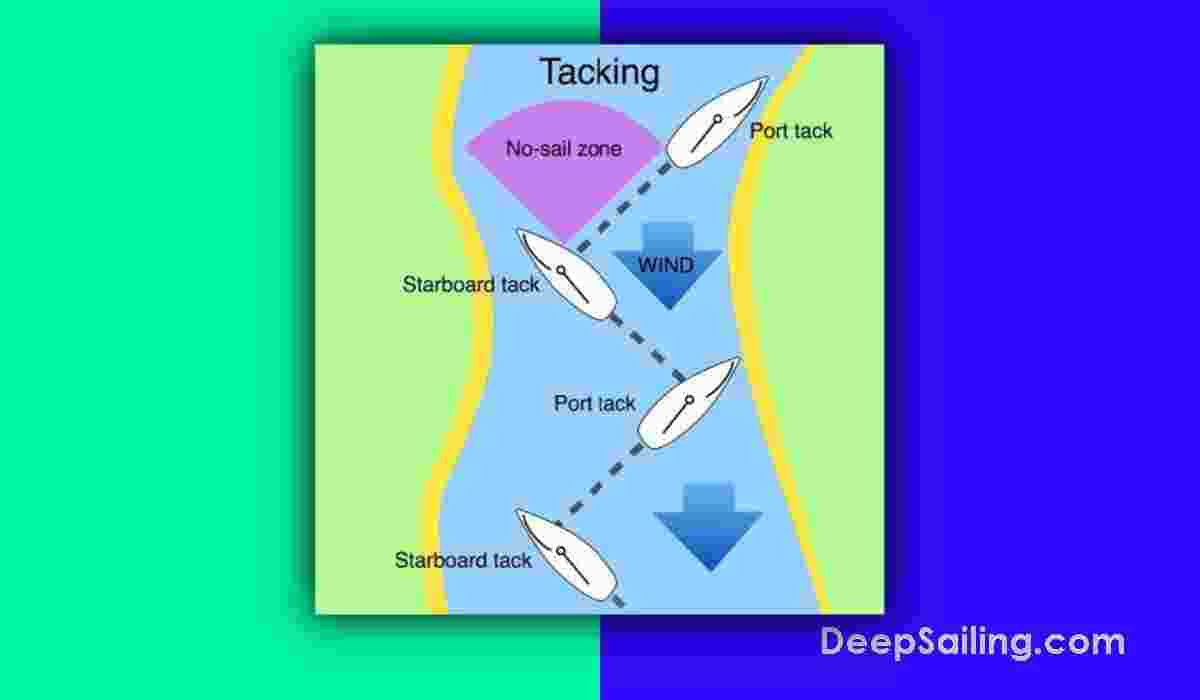
The second step of sailing into the wind is to tack the sailboat, also known as "tacking".
Tacking is a sailing maneuver used to change the direction of a sailboat by turning the bow of the boat through the wind. This is also known as "coming about" or "beating."
When sailing, tacking is used to sail against the wind or to change the direction of the boat when sailing at an angle to the wind.
The tacking sailing maneuver means a sailboat will sail in a zig-zag direction against the wind rather than sailing at a 90-degree angle windward. The zig-zag direction change means the wind will alternate between blowing on the starboard side and blowing on the port side.
For example, if the wind is blowing from the north, tacking would mean sailing the sailboat in the direction between northeast and northwest rather than directly north.
To tack a sailboat:
- Alert the crew : Alert the crew that you're about to tack the sailboat to prepare them to go to a close haul. Close hauled is a sailing term used to describe the point of sail where the boat is sailing as close to the wind as possible. This means that the boat is heading upwind with the sails trimmed in tight and the wind coming from the side of the boat
- Tighten the mainsheet : Tightening the mainsheet is used to adjust the angle of the mainsail in relation to the wind. The mainsheet is the rope that controls the mainsail and it runs from the sail to the aft end of the boat
- Adjust the angle of the sails : Adjust the angle of the sails until the sailboat is sailing at a 45-degree angle against the wind. Sailing at a 45-degree angle to the wind direction will allow the sailboat to sail close-hauled and help it to travel in the direction of the wind without being stopped by the wind forces
The keel of the sailboat will provide stability and prevent the sailboat from capsizing or being blown sideways by the wind. The keel is a heavy, vertical fin-like structure that extends down into the water from the bottom of the sailboat's hull.
As the sailboat moves against the wind through the water at a 45-degree angle, the keel acts as a counterbalance to the force of the wind on the sails, helping to keep the boat upright and on course.
3. Use The Tiller/Steering
The third step of sailing against the wind is to continuously use the tiller/steering on the sailboat. When sailing against the wind, the tiller or steering is an essential tool that the sailor uses to maintain the boat's course and angle to the wind.
Using the tiller/steering system when sailing against the wind will:
- Keep the boat close-hauled : When sailing against the wind, the boat needs to be pointed as close to the wind as possible. This is known as close-hauled sailing. To achieve this, the sailor must use the tiller or steering to keep the boat pointed upwind which helps the boat maintain its course and speed at a 45-degree angle to the wind direction
- Balance the boat : When sailing against the wind, the boat is heeled over to one side as the force of the wind pushes against the sails. The sailor should use the tiller or steering to balance the boat and prevent it from tipping over. This involves making small adjustments to the boat's angle and direction to maintain a stable and controlled sailing posture. The keel will also help with the balance of the boat in the wind
- Maintain forward momentum : Sailing against the wind requires a delicate balance between pointing the boat upwind and maintaining forward momentum. The sailor should use the tiller or steering to maintain the boat's speed and ensure that it is moving steadily forward even when sailing directly into the wind. Getting the right balance between sailing in a zig-zag pattern and maintaining boat speed is crucial
With practice and experience, sailors can become skilled at using the tiller/steering to navigate against the wind and enjoy the unique challenges and rewards of sailing upwind.
When steering the boat against the wind, a sailor should avoid:
- Turning the boat too slowly : When steering the boat against the wind, avoid turning too slowly when tacking as this can cause the sailboat to get caught in irons which can halt any progress when sailing against the wind
- Oversteering : When steering the boat against the wind, avoid steering it too much (oversteering) as this can result in the sailboat not pointing at a 45-degree angle against the wind and instead have the point of sail close reach or broad reach which will halt progress when sailing against the wind
- Tangling the jib sheet : Jib sheets might tangle with some fixtures on the fore deck and will need to be unwrapped. To prevent this from happening, close all fore deck hatches, keep some tension on both jib sheets before and during the tack and clear off any item that may snag the sheets
4. Adjust The Sails Continuously
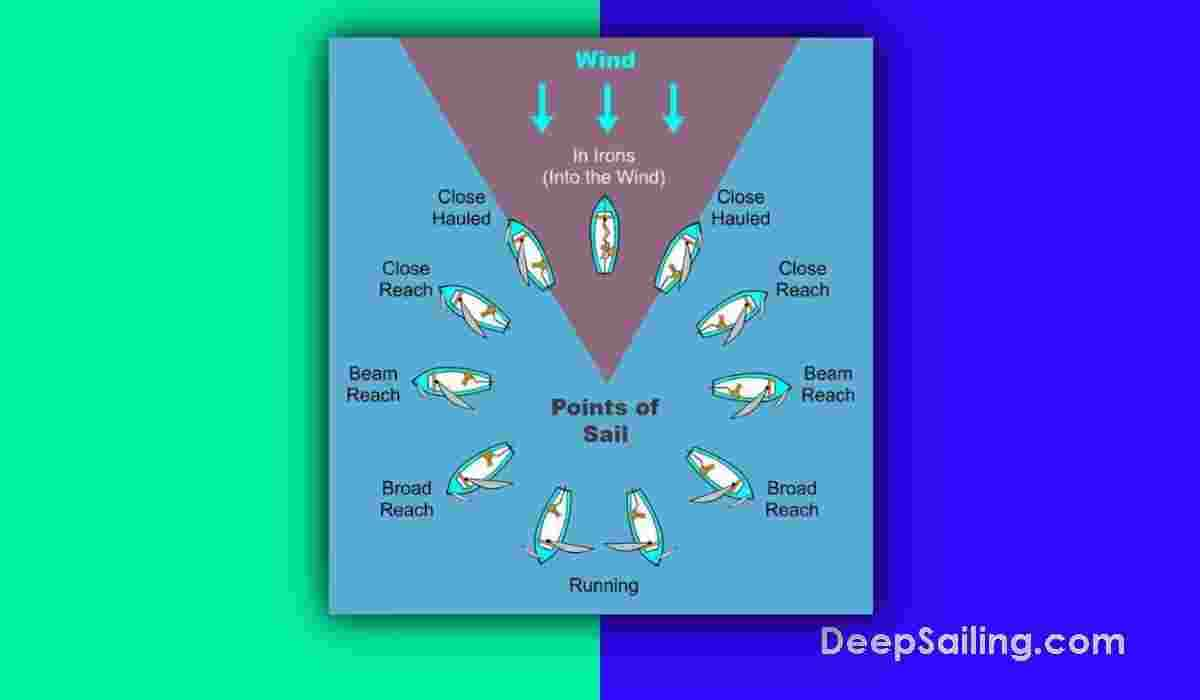
The fourth step of sailing against the wind is to continuously adjust the sails as the sailboat progresses upwind.
To adjust the sails when sailing against the wind:
- Trim the sails : To sail efficiently upwind, the sails need to be trimmed in tight. This means pulling the mainsail in close to the centerline of the boat and tightening the jib sail to bring it as close to the wind as possible. This will help the boat maintain its course and speed and reduce the amount of sideways drift.
- Watch the telltales : The telltales are small strips of ribbon or yarn that are attached to the sails and help the sailor gauge the airflow across the sail. When sailing against the wind, the telltales on the jib sail should be flowing straight back indicating that the sail is at the proper angle to the wind. If the telltales are fluttering or streaming forward, the sail may need to be adjusted
- Use the boom vang : The boom vang is a line that runs from the bottom of the mast to the boom and helps control the shape of the mainsail. When sailing upwind, the boom vang can be tightened to flatten the mainsail and reduce its draft. This can help the boat sail more efficiently and maintain forward momentum
- Adjust the traveler : The traveler is a device that runs across the cockpit or deck and allows the mainsail to be adjusted from side to side. When sailing upwind, the traveler can be moved windward to help keep the boat on course and maintain a balanced sail plan
Overall, adjusting the sails when sailing against the wind is a delicate balance between maximizing efficiency and maintaining control.
With practice and experience, sailors can learn to adjust the sails to suit the prevailing wind conditions and sail upwind with confidence and skill.
Frequently Asked Questions
Below are the most commonly asked questions about sailing against the wind.
How Long Does It Take To Learn How To Sail Against The Wind?
It will take a beginner sailor 3 to 5 attempts to properly sail a sailboat against the wind without any supervision. The timeframe of this is typically within 1 week of practicing 3 to 5 times. However, some sailors may take longer.
What Are The Forces When Sailing Against The Wind?
When sailing against the wind, there are four forces at play:
- Wind Force : The wind is the primary force that is opposing the motion of the sailboat. As the boat sails into the wind, the wind exerts a force on the sails that resists the forward motion of the boat
- Lift Force : The sails generate lift which is a force that propels the boat forward. When sailing against the wind, the lift force is reduced as the sails are not able to generate as much lift as when sailing with the wind
- Resistance Force : As the boat moves through the water, it creates a resistance force which is the force that opposes the forward motion of the boat. This force is influenced by the shape of the hull, the size of the boat, and the speed of the boat
- Friction Force : The friction between the water and the hull of the boat generates a force that opposes the forward motion of the boat. This force increases as the speed of the boat increases
When sailing against the wind, the opposing forces of wind and resistance become more dominant making it more difficult for the boat to move forward.
Sailors use the tacking technique which involves zigzagging back and forth across the wind to make progress against the wind. This allows the boat to use the lift force of the sails more effectively while minimizing the resistance force.
What Are The Benefits Of Sailing Against The Wind?
The benefits of sailing against the wind are:
- Improved sailing skills : Sailing against the wind requires more skill and technique than sailing with the wind. It can be a great way to improve your sailing skills as you learn how to adjust the sails, steer the boat, and navigate more effectively
- Access to more destinations : When sailing with the wind, a sailor's options for destinations may be limited by the wind direction. However, when sailing against the wind, a sailor can access more destinations that may have been previously out of reach
- Greater control : Sailing against the wind requires more attention and focus but it gives a sailor greater control over the boat. A sailor can fine-tune the sails and the boat's position to optimize the speed and direction without issues or limitations
- Challenge and adventure : Sailing against the wind can be a thrilling and adventurous experience. It requires mental and physical toughness and the satisfaction of successfully navigating against the wind can be very rewarding
Overall, while sailing against the wind may require more effort and skill, it can also provide a unique and exciting sailing experience with its own set of rewards.
What Are The Risks Of Sailing Against The Wind?
The risks of sailing against the wind are:
- Increased risk of capsizing : When sailing against the wind, the boat may be more prone to capsizing due to the combination of wind and waves. The boat may be more difficult to control in these conditions and sailors will need to be prepared for any issues with the sailboat capsizing
- Fatigue and physical strain : Sailing against the wind requires more physical effort and can be more tiring than sailing with the wind. This can lead to fatigue and physical strain which can affect a sailor's ability to navigate safely
- Navigation challenges : Sailing against the wind may require more careful navigation and planning as sailor may need to navigate around obstacles and adjust their course more frequently. This can be challenging especially in unfamiliar waters or adverse weather conditions
- Increased wear and tear on equipment : Sailing against the wind can be more taxing on the sailboat equipment as the sails and rigging are subject to greater stress, force, and strain. This can increase the risk of equipment failure or damage
To mitigate these risks, it is important to be prepared and to have the proper training and experience to handle sailing against the wind. This includes ensuring that the sailboat and equipment are in good condition, understanding the weather and navigation conditions, and taking appropriate safety precautions. It is also important to stay alert and attentive while sailing and to make adjustments as needed to ensure safe navigation.
What Should Be Avoided When Sailing Against The Wind?
When sailing against the wind, sailors should avoid:
- Pinching : Pinching is a term used in sailing to describe the act of sailing too close to the wind. When sailing against the wind, the boat needs to sail at a 45-degree angle to the wind to maintain forward momentum and speed. Sailors should avoid pinching when sailing against the wind
- Sailing in irons : Sailing in irons is when a sailboat is sailing directly against the wind. This will prevent the boat from moving forward against the wind and instead the sail angle will need to be adjusted to close haul to progress further
- Turning too slowly or oversteering : When sailing upwind, avoid turning the sailboat too slow or oversteering it as this can affect the ability of the boat to travel against the wind effectively

- Find A School
- Certifications
- North U Sail Trim
- Inside Sailing with Peter Isler
- Docking Made Easy
- Study Quizzes
- Bite-sized Lessons
- Fun Quizzes
- Sailing Challenge

How A Boat Sails Upwind
By: Zeke Quezada, ASA Learn To Sail , Sailing Tips
A sailor’s life revolves around the wind. Its direction and its strength govern where he can sail, with what degree of difficulty or comfort, and how quickly. Naturally, the language of sailing reflects how sailors orient themselves and everything around them with reference to the wind.
Upwind and Downwind
The sailor’s world is roughly divided into two hemispheres: upwind and downwind. anywhere or anything in the direction from which the wind is blowing is upwind; anywhere or anything in the direction toward which it’s blowing is downwind.

When sailing, you trim the sails according to the wind direction relative to the boat. As you learn to sail, the all-important “points of sail” become second nature. When you are out on the water, you’ll be constantly aware of them as the wind changes and as your course changes. You will continually fine-tune the trim of your sails to suit the degree to which you are sailing upwind or downwind.
By understanding the points of sail and their implications on crew comfort and sail trim, the helmsman and the crew will be able to work together to move the boat efficiently to any destination they choose.
Sailing Close-hauled
You sail close-hauled on the very edge of the no-sail-zone — making your best speed toward a destination to windward. This involves a balancing act between boat speed and your course, or angle to the wind. For most boats, that angle is about 45 degrees to the true-wind direction, but it varies with the design of the boat, the shape of the sails (both their geometry and physical condition), and the strength of the wind.
If you attempt to sail a course above close-hauled, or closer to the wind, the sails will no longer deliver full power and the boat will slow down. Sailing a course below close-hauled (or footing off), would be faster but, if your destination is upwind, you would not be making as much progress toward it. Close-hauled is that happy confluence of speed and course that brings the boat upwind with maximum efficiency. Many sailors find close-hauled the most enjoyable point of sail. The wind (this is the apparent wind, remember) will feel the strongest in the crews faces, while the boat bounces along merrily over the waves (maybe sending a bit of spray-on deck) heeling more than on any other point of sail. All of this adds to the exhilaration and fun of sailing.
Start on a beam reach and head up about 45 degrees. Concurrently trim the jib sheet tightly (but not rock hard). Trim the mainsail to the point that its luff just stops bubbling. The boom will lie a little off centerline. experiment with small changes to the trim of both sails — it’s a fine art!
Steering is especially important when sailing close-hauled because with the sails pulled in tight there’s no more to trim in. The driver must be constantly adjusting course to any shifts of wind.
Telltales, short dark yarns or nylon strips streaming on the jib a foot or two back from the luff are an excellent closehauled steering aid.

Except in very light winds, when the boat is barely moving, the helmsman, whether using a tiller or a wheel, should always sit on the windward side for visibility and control. When you’re steering just a little too close to the wind, or pinching, the warning signs are obvious: The jib begins to luff at its leading edge, signaling your entry into the no-sail zone.
When you steer just slightly lower than your optimum close-hauled course, the sails will look full but you are no longer making your best speed to windward. Get in the groove! Concentrate on steering as close to the wind as possible without causing that small luff in the front of the jib with its associated loss of speed.
So now you’re in the groove, but don’t get too comfortable. You’re trying to get to windward, and there’s only one way to get there and that’s by a series of changes in course.

Tacking — Getting From Zig to Zag and Back
A sailboat cannot make any forward progress directly into the wind. When you tried to sail too close to the wind, the sails simply flapped and you lost headway. You may even have put the boat in irons. To reach a destination directly upwind, you have to sail a zigzag course. each leg of the zigzag will be approximately 45 degrees away from the direct line between your starting point and your destination. Think of climbing up a mountain on a trail with a series of switchbacks. This means at some point, you have to get from your zig course to your zag course, which is on the other side of the no-sail zone.
Tacking Defined
When you turn the boat so that its bow passes entirely through the wind — that is, through the no-sail zone — that’s called tacking. The word tack gets a bit of a workout here, just as you will when you tack the boat.
When the boat is sailing with the wind blowing on the starboard side, it’s on starboard tack, and when the wind is blowing on the port side, the moving sailboat is on port tack. To reach a destination directly toward the wind, you have to sail, using the steering skills you just learned, part of the way close-hauled on starboard tack and part of the way close-hauled on port tack. To bring the boat from close-hauled on starboard tack to close-hauled on port tack, you must pass through the no-sail zone — you have to tack.
Tack, Tacking, And Tacks
Where do the apparently multiple meanings of “tack” come from? An old-time square sail was supported along its top by a horizontal spar, or yard, and had control lines on the bottom two corners. When sailing closehauled, one of those corners was hauled forward and down, and was therefore the tack of the sail, and the other was hauled aft. If the wind was on the starboard side, the starboard corner was the tack — starboard tack. To go from sailing with the wind on the ship’s starboard side to sailing with it on the port side, the crew had to literally change tacks.
Of course, we also use the term coming about to mean tacking.
Sailing Upwind
The ability of a modern sailboat to sail close-hauled, sometimes even closer than 40 degrees to the wind’s direction, is due to the boat’s design and the shape of its sails and the forces they generate.
Lift, Drag, and Leeway
The net sum of the forces in play (sail, keel, and rudder) is the forward motion we enjoy. the wind blowing over the airfoil-shaped sails creates a forward force in the form of aerodynamic lift arising from the pressure difference between the windward and leeward sides of the sails. It also creates the sideways force that causes heeling and, even when the forces are in balance and the boat is steering “straight,” a small amount of leeway.
The hull and keel resist motion, both forward and sideways, because of their inherent drag, but once moving forward, the keel, because of the leeway, is at an angle to the water flow. In just the same way as the rudder generates lift when turned, the keel generates an additional forward force from its hydrodynamic lift.
When the forces are balanced, the boat sails in a straight line but with a few degrees of leeway. however, because of the frequent variations in the wind’s strength and the effect of waves on the hull and keel, this balance is hard to achieve simply with sail trim. the rudder provides the turning force that corrects for changes in the balance.
Related Posts:

- Learn To Sail
- Mobile Apps
- Online Courses
- Upcoming Courses
- Sailor Resources
- ASA Log Book
- Bite Sized Lessons
- Knots Made Easy
- Catamaran Challenge
- Sailing Vacations
- Sailing Cruises
- Charter Resources
- International Proficiency Certificate
- Find A Charter
- All Articles
- Sailing Tips
- Sailing Terms
- Destinations
- Environmental
- Initiatives
- Instructor Resources
- Become An Instructor
- Become An ASA School
- Member / Instructor Login
- Affiliate Login

Hatteras Sailing
encouraging youth sailing and competitive opportunities
Sailing Upwind and Tacking
It is very easy on a sailboat, windsurfer, or even a kiteboard to be taken downwind so far that you have a miserable experience trying to get back to where you started. Once you learn how to sail upwind correctly and efficiently, sailing becomes much more enjoyable, if for no other reason, you can feel confident in your ability to get home and/or back to your starting point.
The science of sailing upwind is actually amazing. People unfamiliar with sailing always seem amazed when the learn that sailboats can actually sail into the wind. This is partially true, but only to a certain degree, and this is called sailing close hauled with your sail or sails trimmed in most all the way. The process of making your way upwind by tacking back and forth is know as beating upwind.
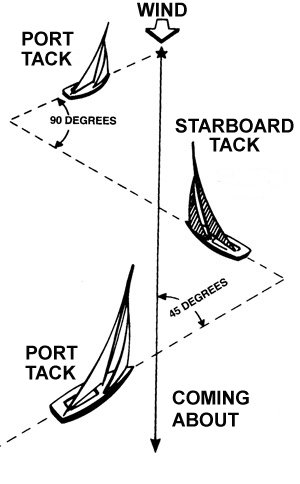
In the image above, a sailboat is shown sailing in a zig zag pattern about 45 degrees off the wind direction and making its way upwind. Notice the sails are sheeted in tightly and the boom is almost over the centerline of the boat hull. When the boat turns from a Port Tack to a Starboard Tack, this maneuver is called TACKING. Learning to tack upwind efficiently, so you dont loose ground and go backward or just too slow upwind, you need to learn specific techniques of where to sit correctly; how to sheet your sails during and through the tack, how to move correctly from one side of the boat to the other and how to steer smoothly through the tack so you do not over/under steer and slow yourself down unecessarily. We will practice this very often because practice is the only way to learn and get use to the correct techniques to operate the boat safely and confidently… and maybe be able to win some sailboat races someday soon!
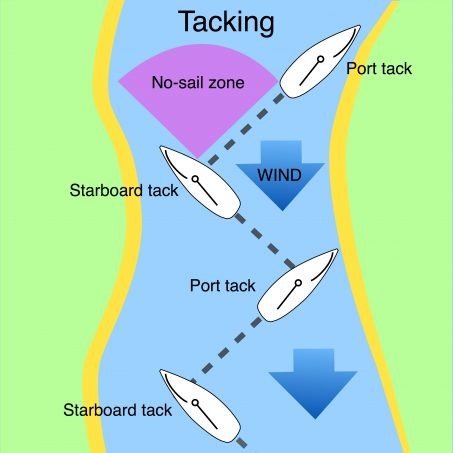
This image shows the same thing as the other one, but with the complication of a narrow channel added to the situation, which is exactly the same as our situation sailing in and out of the canal in Avon! Look familiar?
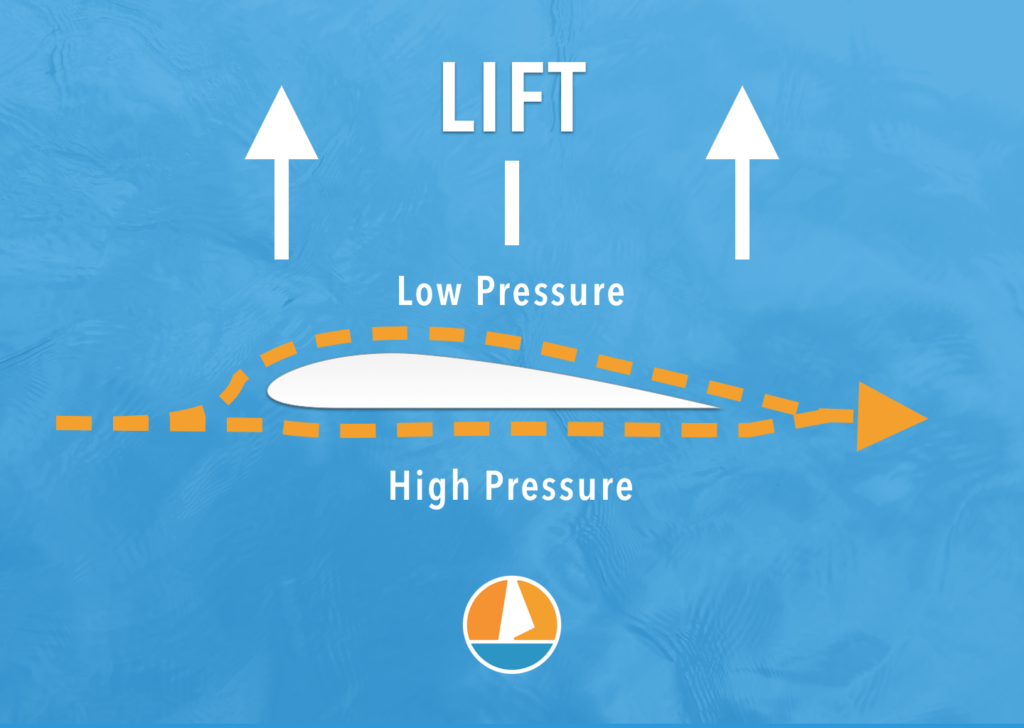
The amazing science of sailing upwind is the same for airplanes, gliders, kites, foils, or any type of water vessel/boat or airplane. When sailing UPWIND the sail is actually being SUCKED into the direction of the wind… not pushed! You can illustrate this in your kitchen by dangling a big tablespoon from your fingertips and running water down it and you’ll see the spoon lifting sideways from the water flowing over it. But this is why it is so important to understand your sail shape and how to adjust it for the wind conditions and speed. If your mainsheet is too loose, for example, your sail will flutter or luff in the wind and have no shape and simply not work right. If you over tighten your mainsheet, you will stall your sail…… which isnt so bad on a sailboat, but if you did the same mistake on an airplane, you would fall out of the sky.

For the Scientific Minded, you should be incredibly challenged to make the sail work perfectly. For those less technical, remember one thing! While steering your boat upwind with your sheets close hauled, you can “Head Up” until your sails just start to begin luffing, to test that your steering as “Close” to the wind as possible and not in the NO GO ZONE, and then bear off slightly…. SLIGHTLY… until your sails just stop luffing, then you know you are on a good course. Then keep that course, but be mindful that the wind does shift constantly, normally in small degrees, but that you may need to be really vigilant and keep testing that you are on your best upwind heading so you get to the upwind mark or finish line before the others do!
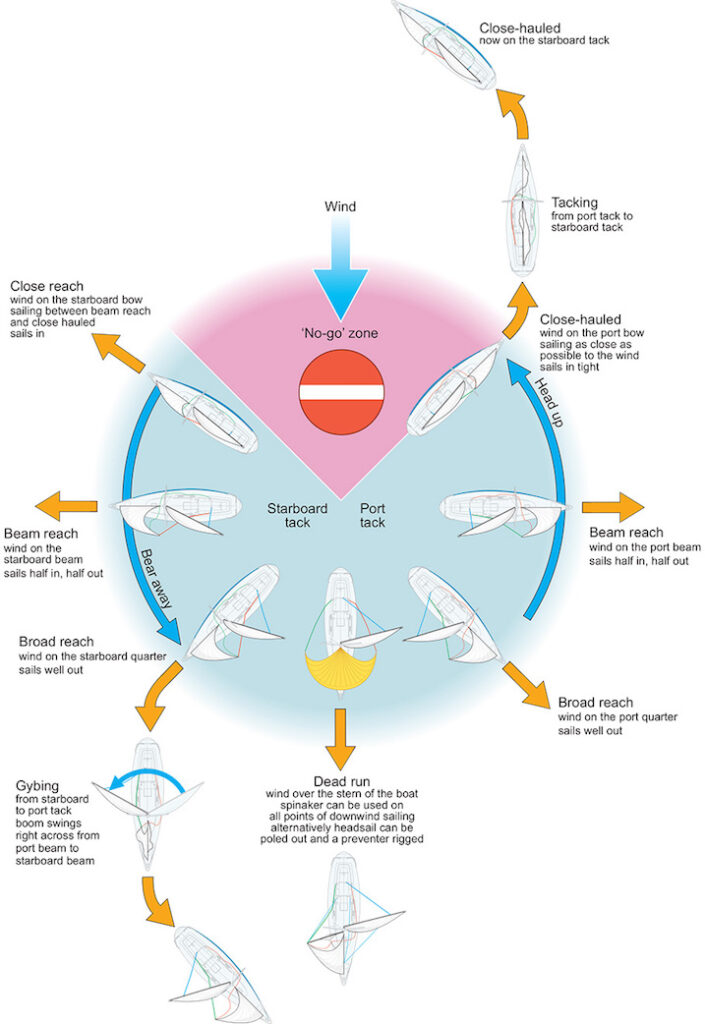
Please study these pictures and try your best to understand them. When you come back to Sailing Class next week, we will sit down and try to clarify anything you may not understand. The better you understand this upwind sailing challenge, the faster it will start to become easy for you to sail fast UPWIND on your boat!
Here are some additional videos on sailing your Opti Upwind
- https://www.youtube.com/watch?v=V_FppGg23X4
- https://www.youtube.com/watch?v=c8YCByrWYrk
- https://www.youtube.com/watch?v=AEf_VZtyc-k
- https://www.youtube.com/watch?v=H9qCSBQa9Zw
This one is really really good on form, where to sit, how to trim, how to hold the lines. https://youtu.be/LHhXD5jKL3w
…if you are over 70lbs it is very important where you sit
Comments are closed.
Please use a modern browser to view this website. Some elements might not work as expected when using Internet Explorer.
- Landing Page
- Luxury Yacht Vacation Types
- Corporate Yacht Charter
- Tailor Made Vacations
- Luxury Exploration Vacations
- View All 3576
- Motor Yachts
- Sailing Yachts
- Classic Yachts
- Catamaran Yachts
- Filter By Destination
- More Filters
- Latest Reviews
- Charter Special Offers
- Destination Guides
- Inspiration & Features
- Mediterranean Charter Yachts
- France Charter Yachts
- Italy Charter Yachts
- Croatia Charter Yachts
- Greece Charter Yachts
- Turkey Charter Yachts
- Bahamas Charter Yachts
- Caribbean Charter Yachts
- Australia Charter Yachts
- Thailand Charter Yachts
- Dubai Charter Yachts
- Destination News
- New To Fleet
- Charter Fleet Updates
- Special Offers
- Industry News
- Yacht Shows
- Corporate Charter
- Finding a Yacht Broker
- Charter Preferences
- Questions & Answers
- Add my yacht
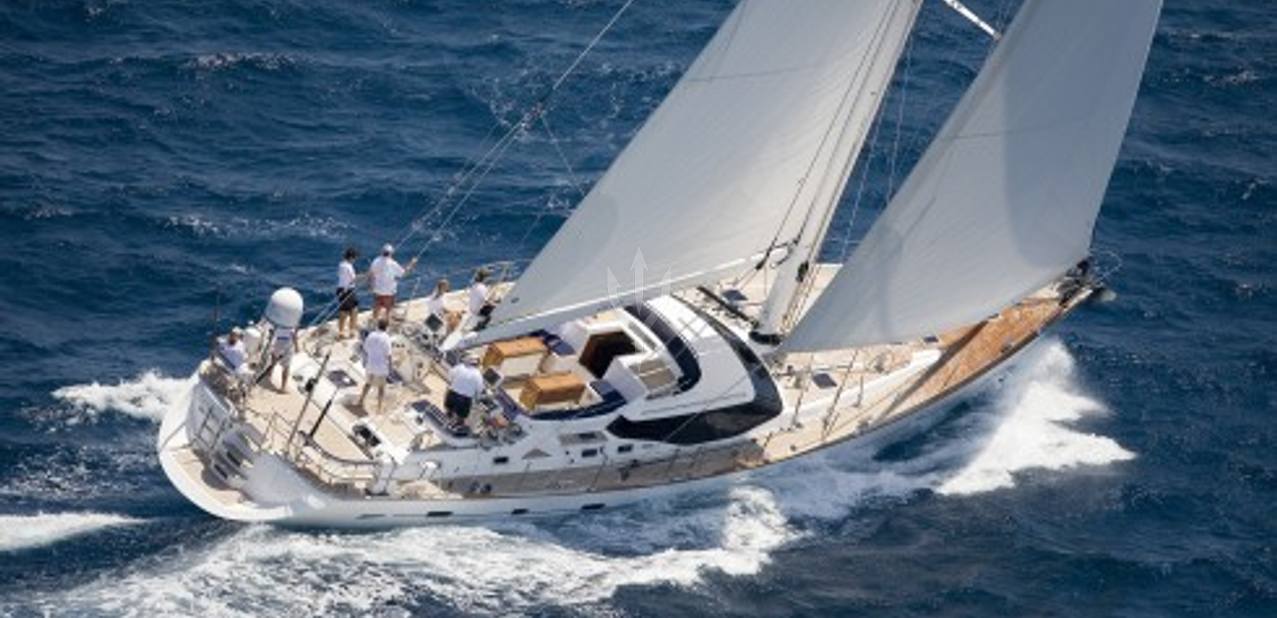
NOT FOR CHARTER *
This Yacht is not for Charter*
SIMILAR YACHTS FOR CHARTER
View Similar Yachts
Or View All luxury yachts for charter
- Luxury Charter Yachts
- Sailing Yachts for Charter
- Amenities & Toys
ZIG ZAG yacht NOT for charter*
25m / 82' | oyster yachts | 2007.
Owner & Guests
Cabin Configuration
- Previous Yacht
The 25m/82' sail yacht 'Zig Zag' was built by Oyster Yachts at their Ipswich, Suffolk shipyard. Her interior is styled by design house Oyster Yachts and she was completed in 2007. This luxury vessel's exterior design is the work of Rob Humphreys.
Guest Accommodation
Zig Zag has been designed to comfortably accommodate up to 6 guests in 3 suites. She is also capable of carrying up to 4 crew onboard to ensure a relaxed luxury yacht experience.
Range & Performance
Zig Zag is built with a GRP hull and GRP superstructure, with teak decks. Zig Zag comfortably cruises at 8 knots, reaches a maximum speed of 10 knots. Her water tanks store around 3,000 Litres of fresh water.
*Charter Zig Zag Sail Yacht
Sail yacht Zig Zag is currently not believed to be available for private Charter. To view similar yachts for charter , or contact your Yacht Charter Broker for information about renting a luxury charter yacht.
Zig Zag Yacht Owner, Captain or marketing company
'Yacht Charter Fleet' is a free information service, if your yacht is available for charter please contact us with details and photos and we will update our records.
Zig Zag Photos
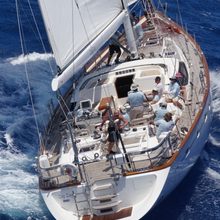
NOTE to U.S. Customs & Border Protection
Specification
S/Y Zig Zag
SIMILAR LUXURY YACHTS FOR CHARTER
Here are a selection of superyachts which are similar to Zig Zag yacht which are believed to be available for charter. To view all similar luxury charter yachts click on the button below.
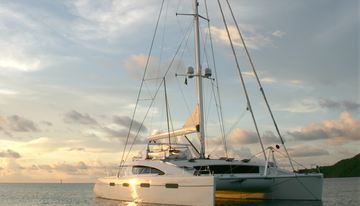
23m | Matrix Yachts
from $46,800 p/week
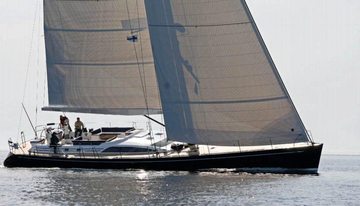
25m | Nautor's Swan
from $39,000 p/week
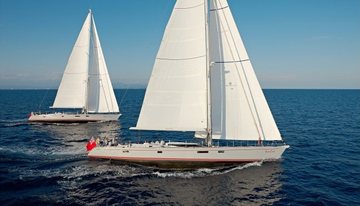
Amazon Creek
from $24,000 p/week

from $39,500 p/week
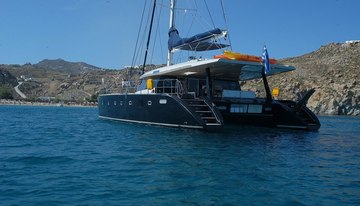
19m | Sunreef Yachts
from $21,000 p/week ♦︎
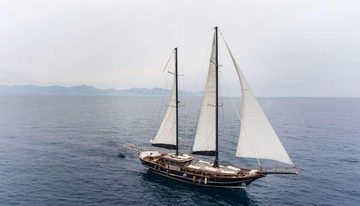
24m | Custom
from $18,000 p/week ♦︎

21m | Sunreef Yachts
from $32,000 p/week ♦︎
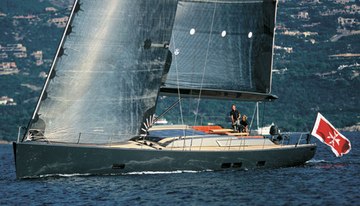
24m | Wally
from $28,000 p/week ♦︎
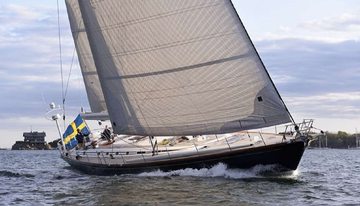
from $25,000 p/week
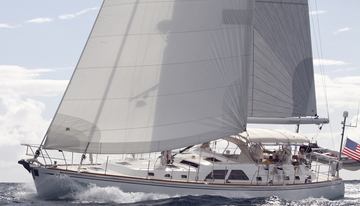
21m | Hylas
from $18,900 p/week

19m | Lagoon
POA ♦︎
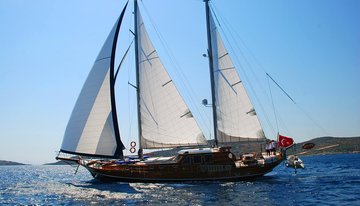
from $11,000 p/week ♦︎
As Featured In
The YachtCharterFleet Difference
YachtCharterFleet makes it easy to find the yacht charter vacation that is right for you. We combine thousands of yacht listings with local destination information, sample itineraries and experiences to deliver the world's most comprehensive yacht charter website.
San Francisco
- Like us on Facebook
- Follow us on Twitter
- Follow us on Instagram
- Find us on LinkedIn
- Add My Yacht
- Affiliates & Partners
Popular Destinations & Events
- St Tropez Yacht Charter
- Monaco Yacht Charter
- St Barts Yacht Charter
- Greece Yacht Charter
- Mykonos Yacht Charter
- Caribbean Yacht Charter
Featured Charter Yachts
- Maltese Falcon Yacht Charter
- Wheels Yacht Charter
- Victorious Yacht Charter
- Andrea Yacht Charter
- Titania Yacht Charter
- Ahpo Yacht Charter
Receive our latest offers, trends and stories direct to your inbox.
Please enter a valid e-mail.
Thanks for subscribing.
Search for Yachts, Destinations, Events, News... everything related to Luxury Yachts for Charter.
Yachts in your shortlist


Why Do Sail Boats Zig Zag?
Have you ever wondered why sailboats seem to zigzag their way through the water? This interesting phenomenon is called tacking, and it’s a crucial part of sailing. In this article, we’ll explore why sailboats tack and how it works.
What is Tacking?
Tacking is the process of sailing a boat against the wind by changing its direction back and forth. When a sailboat is headed directly into the wind, its sails can’t catch any air, which means it can’t move forward. To overcome this problem, sailors use tacking to move the boat forward at an angle to the wind.
How Does Tacking Work?
To tack a sailboat, sailors turn the boat’s bow through the wind until the sails catch air on the opposite side. This causes the boat to change direction and start moving in a new direction that’s at an angle to the wind. As the boat picks up speed, sailors gradually turn its bow back toward where they want to go until they’re once again headed in their desired direction.
The Role of Sail Shape
The shape of a sail plays an important role in tacking. Sailors adjust their sails’ shape depending on whether they’re tacking or sailing with the wind behind them. When tacking, they flatten out their sails so that they don’t catch too much air on either side as they move through each turn.
The Importance of Timing
Timing is also critical when tacking a sailboat. If sailors turn too quickly through the wind or don’t adjust their sails fast enough, they risk losing momentum and getting stuck in what’s called “irons,” where they can’t move forward or backward at all.
The Benefits of Tacking
While tacking may seem like an inefficient way to get from point A to point B, it actually has several benefits. For one, it allows sailors to navigate against the wind, which would otherwise be impossible. Additionally, tacking can help sailors reach their destination faster by taking advantage of wind shifts and currents.
8 Related Question Answers Found
Why is sail dropping, why is sail stock falling, why is sail making loss, why do motors sail, what force on a sail causes a sailboat to move, why is the sail going down, why do sail boats heel, why do sail boats have two wheels.

Emma Gibson
How Do Sailboats Sail into the Wind?
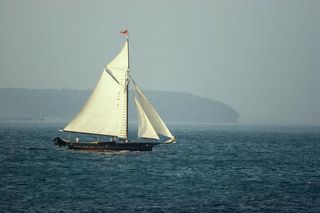
It seems intuitive that sailboats, powered only by the wind, can travel easily with the wind at their backs, but it may seem impossible that they turn around and come home again, with the wind blowing straight against them.
But this reverse movement is possible because a moving boat's sail is shaped as an airfoil like the wing of a plane. When air moves over a plane's wing, from front to back, wind flowing over the top of the wing has to travel farther than wind flowing under the wing's bottom surface. This creates a pressure difference that lifts the plane.
On a sailboat, wind blowing against the boat at an angle inflates the sail, and it forms a similar foil shape, creating a difference in pressure that pushes the sail perpendicular to the wind direction.
According to "The Physics of Sailing Explained" (Sheridan House Inc, 2003), by Kent State University physics professor Bryon D. Anderson, this force from the sail's foil shape is combined with and balanced by other forces, including those of the boat's keel (the long thin piece that juts down from the bottom of the boat).
Together, the forces of drag, from the water, and the pressure from the wind against the sail itself push the craft forward. It moves at an angle opposite the direction of the wind, called windward in sailing terminology.
According to the American Institute of Physics' Physics Today magazine, the keel is especially important because without its balancing action, a boat would simply drift downwind.
Windward sailing also does not work if a boat is pointed directly opposite the wind direction, according to The Physics of Sailing. Wind has to be moving against the boat at an angle of at least 40 degrees for most vessels. Angling too sharply into the wind causes the forces on the boat to become unbalanced, and moves the boat sideways in the water.
Sign up for the Live Science daily newsletter now
Get the world’s most fascinating discoveries delivered straight to your inbox.
A sailor intending to travel windward toward a point exactly in line with the direction of the wind will have to zig zag back and forth to reach its target. Using this "tacking" technique, and traveling at an angle as close to the wind's direction as possible, sailors can reach a point in any direction, regardless of the direction of wind.
Got a question? Email it to Life's Little Mysteries and we'll try to answer it. Due to the volume of questions, we unfortunately can't reply individually, but we will publish answers to the most intriguing questions, so check back soon.
Largest gold nugget ever found in England unearthed with faulty metal detector
Polar vortex is 'spinning backwards' above Arctic after major reversal event
4 ways you can help NASA study the April 8 solar eclipse
Most Popular
By Elise Poore March 28, 2024
By Drew Turney March 28, 2024
By Jennifer Nalewicki March 28, 2024
By Emily Cooke March 27, 2024
By Harry Baker March 27, 2024
By Sharmila Kuthunur March 27, 2024
By Colin Caprani March 27, 2024
By Orla Loughran Hayes March 27, 2024
By Jennifer Nalewicki March 27, 2024
By Tom Metcalfe March 27, 2024
- 2 MIT scientists have just figured out how to make the most popular AI image generators 30 times faster
- 3 James Webb telescope confirms there is something seriously wrong with our understanding of the universe
- 4 'You could almost see and smell their world': Remnants of 'Britain's Pompeii' reveal details of life in Bronze Age village
- 5 How to safely record the April 8 eclipse with your phone
- 2 Polar vortex is 'spinning backwards' above Arctic after major reversal event
- 3 Single enormous object left 2 billion craters on Mars, scientists discover
- 4 Why did the atomic bomb dropped on Hiroshima leave shadows of people etched on sidewalks?
- Cambiar Idioma:

“Zig Zag” Catamarán
Belize 43” fountain pajot cat.
Zig Zag is known in Cabo as the best in its category characterized as the most luxurious Catamaran/sailboat. Elegance and service along with the most delightful places Los Cabos and the Peninsula of Baja California Sur offers are what distinguish us from others. Service, service, service!. We have 8 years of experience receiving groups from the most prestigious resorts in Cabo San Lucas, The Corridor and San José del Cabo. Our priority is to create a one of a kind experience so our guests can remember it as the highlight of their trip.
OUR BILINGUAL CREW is fully qualified to deal with demanding customers that are used to receive V.I.P treatment. Our Captain is Yacht Master Certified and our Sailor/Chef is also certified so our guests are in the best hands.
OUR TOURS are 100% customized, focusing on fulfilling our guests desires, wishes and needs. How about sailing in the most extraordinary sunsets in Cabo? Encounter with humpback whales (seasonal)? Enjoy the scenary of Lovers Beach and our most antique rock formation symbol of Cabo, The Arch? Snorkel in the waters that Jacque Custeau nicknamed “The Aquarium of the World”? Romance under the full moon? Bachelor and Bachelorette parties? Unique marriage proposals? Weddings? You name it!!!…
YOU DREAM IT, WE WILL MAKE IT HAPPEN!!!
Pleasure or business, let us take care of the details while your guests relax and enjoy the experience that Sail Baja Adventures has to offer.
WELCOME ABOARD!!!

Sail Baja Adventures
Boarding Location
Cabo san lucas marina dock f:.

The global authority in superyachting
- NEWSLETTERS
- Yachts Home
- The Superyacht Directory
- Yacht Reports
- Brokerage News
- The largest yachts in the world
- The Register
- Yacht Advice
- Yacht Design
- 12m to 24m yachts
- Monaco Yacht Show
- Builder Directory
- Designer Directory
- Interior Design Directory
- Naval Architect Directory
- Yachts for sale home
- Motor yachts
- Sailing yachts
- Explorer yachts
- Classic yachts
- Sale Broker Directory
- Charter Home
- Yachts for Charter
- Charter Destinations
- Charter Broker Directory
- Destinations Home
- Mediterranean
- South Pacific
- Rest of the World
- Boat Life Home
- Owners' Experiences
- Interiors Suppliers
- Owners' Club
- Captains' Club
- BOAT Showcase
- Boat Presents
- Events Home
- World Superyacht Awards
- Superyacht Design Festival
- Design and Innovation Awards
- Young Designer of the Year Award
- Artistry and Craft Awards
- Explorer Yachts Summit
- Ocean Talks
- The Ocean Awards
- BOAT Connect
- Between the bays
- Golf Invitational
- Boat Pro Home
- Pricing Plan
- Superyacht Insight
- Product Features
- Premium Content
- Testimonials
- Global Order Book
- Tenders & Equipment

ZIG ZAG OCEAN
ZIG ZAG OCEAN is a 44.8 m Motor Yacht, built in Italy by Admiral - The Italian Sea Group and delivered in 2014.
Her top speed is 28.0 kn and her cruising speed is 26.0 kn and her power comes from three MTU diesel engines. She can accommodate up to 10 guests in 5 staterooms, with 8 crew members waiting on their every need. She has a gross tonnage of 439.0 GT and a 8.6 m beam.
She was designed by Luca Dini , who has designed 53 other superyachts in the BOAT Pro database.
The naval architecture was developed by Admiral Centro Stile , who has architected 7 other superyachts in the BOAT Pro database, and the interior of the yacht was designed by Dobroserdov Design - she is built with a Teak deck, a Aluminium hull, and Aluminium superstructure.
ZIG ZAG OCEAN is in the top 30% by LOA and in the top 30% by speed in the world. She is one of 595 motor yachts in the 40-45m size range, and, compared to similarly sized motor yachts, her cruising speed is 9.73 kn above the average, her top speed 8.37 kn above the average, and her volume 56.52 GT above the average.
ZIG ZAG OCEAN is currently sailing under the Malta flag, the 3rd most popular flag state for superyachts with a total of 1063 yachts registered. She is currently located at the superyacht marina Athens Marina, in Greece, where she has been located for 2 months. For more information regarding ZIG ZAG OCEAN's movements, find out more about BOAT Pro AIS .
Specifications
- Name: ZIG ZAG OCEAN
- Previous Names: FLYING DRAGON
- Yacht Type: Motor Yacht
- Yacht Subtype: Planing Fast Yacht
- Builder: Admiral - The Italian Sea Group
- Naval Architect: Admiral Centro Stile
- Exterior Designer: Luca Dini
- Interior Designer: Dobroserdov Design
- Refits: 2017-06-30
Yacht featured in
Yachts like this, from our partners, sponsored listings.
Welcome aboard Zig Zag Your Sailboat Charter
Cruise aboard our 30' catalina yacht.
Sailing in Tampa Bay, from Anna Maria Island, Florida
Experience The Joy Of Sailing
Enjoy a sailboat cruise on the beautiful emerald green waters of Tampa Bay and the Gulf of Mexico, just minutes from Bradenton, Florida. Take a turn at the helm or just relax and watch the dolphins play. Your cruise with Spice Sailing Charters will be the highlight of your vacation.
Other services available include sailing lessons and memorials for your loved ones with At Sea Burials.
Witness Our Glorious Tampa Bay Sunsets
Charter a sunset cruise aboard, Zig Zag, a comfortable and spacious 30 foot sailboat. Bring some wine and cheese, and be prepared to take home spectacular memories and awesome photos of your sailing experience off the coast of Anna Maria Island.

Sail With Captain Ed Hartung
- U.S.C.G. Licensed and charter captain since 1988
- 100 Ton Masters License from the United States Coast Guard
- Cruises and races to Mexico, Cuba and the Virgin Islands
- Over 25 years of sailboat chartering experience in Tampa Bay and the Gulf of Mexico
- His sailing experience has included local and long distance yacht deliveries
- Sailboat charters serving Anna Maria Island, Holmes Beach, Longboat Key, Bradenton, Sarasota, Palmetto, Ellenton, in the Tampa Bay area
"Ed Hartung is one of The Finest, most safety conscious sailors, I have ever sailed with." Tom Newmann
"Ed is a very skilled and experienced sailboat charter captain. But more importantly, he will go well out of his way to ensure that all his passengers have a wonderful time aboard Zig Zag." Jay Winters
Checkout Learn Sailing Fun and Easy ($9. 95 )
- Bahasa Indonesia
- Slovenščina
- Science & Tech
- Russian Kitchen
How the USSR built the ‘ideal’ communal cities (PHOTOS)
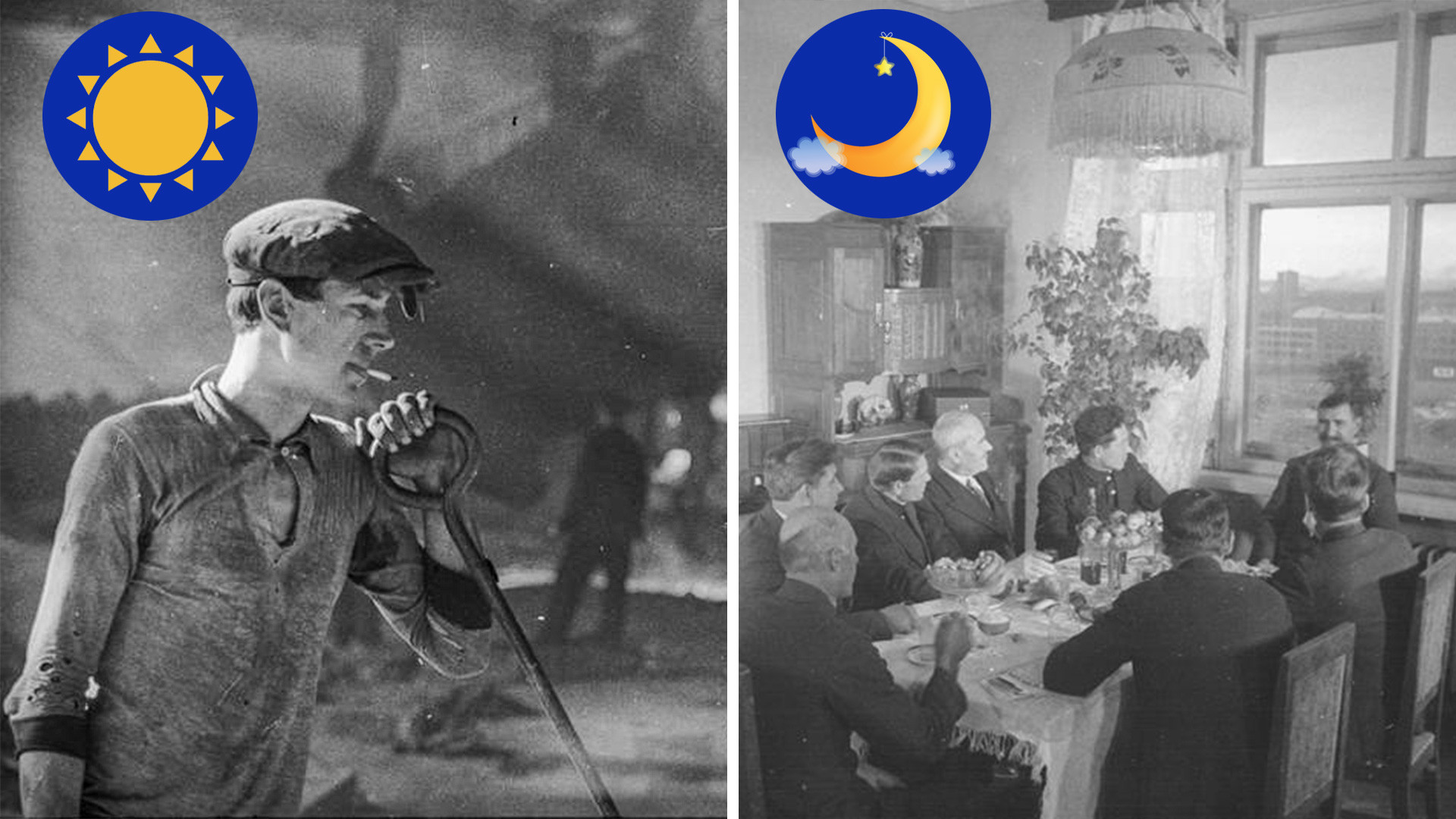
The plan of the future settlement in Novosibirsk.
In the 1930s, when the Soviet Union expanded its industrialization program and began constructing factories throughout the whole country, a flow of people poured into the cities from villages and the countryside. There wasn’t enough space in the old districts and people arriving to larger construction sites were forced to live in tents, underground dwellings, as well as makeshift homes. It was essential to build not only homes, but critical infrastructure.

Novokuznetsk, 1932. The first houses for workers.
New districts, which were dubbed, “socialist cities”, were expected to provide housing to millions of people in the shortest amount of time and simultaneously meet the ideological objectives of the time. People accustomed to private property, now received housing and social services from the government. Moreover, all the necessities were roughly identical, from furniture to entertainment.

The team of foreign architects. Ernst May is 5th from the left. Nizhny Tagil, 1931.
The first socialist cities were built according to the designs of foreign specialists. Between 1930 and 1933, Soviet leadership invited a group of 17 German and Austrian architects and urban planners. Heading the group was Ernst May, an ideologist of mass standardized residential building design. He was the head architect in Frankfurt am Main, where functional residential neighborhoods were built, including homes and social spaces.

Above: 'Zig-Zag Houses' in Frankfurt designed by May. Below: Sotsgorod in Magnitogorsk.
The ‘May Brigade’ participated in the planning of at least 20 Soviet socialist cities, most of which were in the Ural and Siberian territories (Novokuznetsk, Magnitogorsk, Novosibirsk and many others), offering a new perspective on urban planning policy.

This is how the former socialist city in Novosibirsk looks like today.
The districts bore the names of factories. In large cities, there could be several socialist cities or socialist villages. For example, in Kazan, the socialist cities were Aviastroya, Aviakombinata, and Kazmashstroya. In Stalingrad, there were socialist cities for chemists, shipbuilders and tractor factory workers.

Above: Lessons for the workers. Below: A chess class at the local workers' club.
The main thing that distinguished socialist cities from other districts was the careful planning of new settlements. Life in socialist cities was intended to be communal: residents should work and relax together. Everyday issues like laundry and cooking were intended to be handled by outsourced community services.

Above: Novokuznetsk, Kemerovo Region. Below: A kindergarten in sotsgorod.
Socialist cities were to include low-rise residential neighborhoods, an administrative center, essential stores, canteens , laundry facilities, as well as big and small green spaces for strolling and visual separation of the factory from the residential community. As a rule, the German architects positioned the ends of houses towards the street to reduce exterior noise and the amount of dust on windows. The streets led to the city center. This type of building was called a housing row.

An apartment of a worker's family in Magnitogorsk.
Perhaps, to a modern person, these kinds of homes wouldn’t seem the most attractive; however, for its time, they were considered a true innovation.
Though, the apartments and bedrooms themselves within the communal units were very modest, they were equipped with all the modern comforts which, during that time, were inaccessible to the majority of people. This included, for example, a bathroom. In Novokuznetsk, an industrial city in southern Siberia, “Frankfurt kitchens”' were installed in the apartments in the design of Austrian architect Margarete Schütte-Lihotzky, who also belonged to the ‘May Brigade’. These ergonomic kitchen designs, which made a real revolution around the world, substantially simplified cooking. Yet, places for family time in the apartments weren’t provided: free time needed to be spent within the community.

A house-commune in Novosibirsk, 1934.
In many cities in those districts, the predominant living situation was not in homes with separate rooms, but in residences and communal homes, which best lived up to the utopian ideas about communal life. According to then-Soviet norms, one person was entitled to just 9 m2 (about 97 ft2) of housing.

Sotsgorod in Magnitogorsk, 1950s.
From the mid-1930s, Soviet specialists were already busy planning socialist cities. New neighborhoods were planned with wide buildings and streets. Homes also grew vertically: 7 and 9 story buildings with oriel windows (bay windows), loggias (recessed balconies) and sculptures in Stalin’s ‘Empire’ style. After the Great Patriotic War (known as WWII throughout the rest of the world), the need arose to restore destroyed homes and Soviet architects turned to no-frills panel construction, a style of construction using prefabricated concrete slabs, aiming to provide every family with a separate apartment.

This is how the former socialist city in Nizhny Novgorod looks like today. It's called the Avtozavodsky district of the city.
Today, these socialist cities have become commuter towns, where people from all walks of life live. It’s not necessary to work in a factory to live there either. These historic neighborhoods are regarded as architectural sites in some cities and tours are even organized to visit them.
If using any of Russia Beyond's content, partly or in full, always provide an active hyperlink to the original material.
to our newsletter!
Get the week's best stories straight to your inbox
- 5 masterpieces of industrial architecture in Moscow (PHOTOS)
- How Soviet architects experimented with standardized designs for residential buildings
- How Russia got its own version of ‘American suburbs’ (PHOTOS)
This website uses cookies. Click here to find out more.

References & Citations
- Google Scholar
- Semantic Scholar
BibTeX formatted citation
Bibliographic and Citation Tools
Code, data and media associated with this article, recommenders and search tools.
- Institution
arXivLabs: experimental projects with community collaborators
arXivLabs is a framework that allows collaborators to develop and share new arXiv features directly on our website.
Both individuals and organizations that work with arXivLabs have embraced and accepted our values of openness, community, excellence, and user data privacy. arXiv is committed to these values and only works with partners that adhere to them.
Have an idea for a project that will add value for arXiv's community? Learn more about arXivLabs .

IMAGES
VIDEO
COMMENTS
Tacking (sailing) Tacking: Sailing the craft into the wind from the port tack to the starboard tack. Beating to windward on a series of port and starboard tacks, tacking between each at points 1, 2, and 3. Tacking or coming about is a sailing maneuver by which a sailing craft ( sailing vessel, ice boat, or land yacht ), whose next destination ...
When planning your zig-zag route, keep in mind that the wind will make you drift. Your boat will not travel in a straight line ahead, it will be pushed by the wind wherever it will blow from. Even though you are travelling upwind, since you are going 22 degrees off the wind's course, the wind is still pushing you from one side.
The zig-zagging and the repeated tack will move the boat upwind. You can learn more about tacking a sailboat here. Four Forces. Four forces act on a sailboat trying to sail against the wind. The two that directly affect the boat are the viscosity force of the water and the force of the wind, which propels the boat.
ZIG ZAG. ZIG ZAG is a 24.99 m Sail Yacht, built in the United Kingdom by Oyster and delivered in 2007. She is one of 17 82 models. Her top speed is 11.0 kn and she boasts a maximum range of 1000.0 nm when navigating at cruising speed, with power coming from a Caterpillar diesel engine. She can accommodate up to 6 guests in 3 staterooms, with 4 ...
A sailboat cannot steer directly into the wind and instead must follow a zig-zag course over the ground to make progress in that direction. To tack the sailboat is the action of turning its bow through the wind. This maneuver also called "a tack" (noun), is used to sail into the direction of the wind.
The tacking sailing maneuver means a sailboat will sail in a zig-zag direction against the wind rather than sailing at a 90-degree angle windward. The zig-zag direction change means the wind will alternate between blowing on the starboard side and blowing on the port side. For example, if the wind is blowing from the north, tacking would mean ...
Tacking — Getting From Zig to Zag and Back . A sailboat cannot make any forward progress directly into the wind. When you tried to sail too close to the wind, the sails simply flapped and you lost headway. You may even have put the boat in irons. To reach a destination directly upwind, you have to sail a zigzag course. each leg of the zigzag ...
The process of making your way upwind by tacking back and forth is know as beating upwind. In the image above, a sailboat is shown sailing in a zig zag pattern about 45 degrees off the wind direction and making its way upwind. Notice the sails are sheeted in tightly and the boom is almost over the centerline of the boat hull.
The 25m/82' sail yacht 'Zig Zag' was built by Oyster Yachts at their Ipswich, Suffolk shipyard. Her interior is styled by design house Oyster Yachts and she was completed in 2007. This luxury vessel's exterior design is the work of Rob Humphreys. Guest Accommodation. Zig Zag has been designed to comfortably accommodate up to 6 guests in 3 suites.
Zig Zag is a semi-custom sailing yacht launched in 2007 by Oyster Marine. Oyster Marine was founded in 1973 and has established itself as an international market leader of world-class cruising yachts. With their distinctive Deck Saloon design, Oyster yachts are recognised throughout the sailing world for quality, comfort and performance. ...
Conclusion. In conclusion, sailboats zigzag or tack because it's the only way to sail against the wind. Through tacking, sailors can adjust their sails' shape and timing to move forward at an angle to the wind and ultimately reach their destination. So next time you see a sailboat zigzagging through the water, you'll know exactly why they ...
A sailor intending to travel windward toward a point exactly in line with the direction of the wind will have to zig zag back and forth to reach its target. Using this "tacking" technique, and ...
Let's continue with the essential vocabulary mastery. A series of tacking moves, in a zig-zag pattern, is called beating. The opposite manoeuvre to tacking is called jibing. A jibe consists in turning the stern of the boat through the wind so that the wind changes from one side of the boat to the other side.
"Zig Zag" Catamarán Belize 43" Fountain Pajot Cat. Zig Zag is known in Cabo as the best in its category characterized as the most luxurious Catamaran/sailboat. Elegance and service along with the most delightful places Los Cabos and the Peninsula of Baja California Sur offers are what distinguish us from others. Service, service, service!.
Zig Zag is a sailing yacht with an overall length of m. The yacht's builder is Oyster Yachts from United Kingdom, who launched Zig Zag in 2007. The superyacht has a beam of m and a volume of . GT.. Zig Zag features exterior design by Oyster Yachts and interior design by Oyster Yachts. Up to 8 guests can be accommodated on board the superyacht, Zig Zag, and she also has accommodation for 3 crew ...
Our Boat: Zig Zag A 30 foot Catalina Yacht. Sailing in Tampa Bay and the Gulf of Mexico from Anna Maria Island, Florida. Sailboat Description. The Catalina 30 is a sloop-rigged monohull with an aft-cockpit. It is the largest and longest continuous production keel boat in the world. Its mainsail is raised on a 46 foot mast, and its powerful ...
Check out our sailboat zig zag selection for the very best in unique or custom, handmade pieces from our shops.
GUESTS. 10. ZIG ZAG OCEAN is a 44.8 m Motor Yacht, built in Italy by Admiral - The Italian Sea Group and delivered in 2014. Her top speed is 28.0 kn and her cruising speed is 26.0 kn and her power comes from three MTU diesel engines. She can accommodate up to 10 guests in 5 staterooms, with 8 crew members waiting on their every need.
Spice Sailing Charters offers a 30 foot sailboat, Zig Zag, for charter cruises in Tampa Bay and the Gulf of Mexico, near Anna Maria Island and Bradenton. Captain Ed Hartung is a licensed and experienced captain who can teach you sailing lessons and conduct at sea burials.
On this map you can see the details of the longest and most classic of the Flotilla Radisson boat tours: 2. Companies that do boat tours on the Moskva River. There are many companies that do cruises on the Moskva River, but the 4 main ones are: Capital River Boat Tour Company (CCK) Mosflot. Flotilla Radisson.
Archive photo. The first socialist cities were built according to the designs of foreign specialists. Between 1930 and 1933, Soviet leadership invited a group of 17 German and Austrian architects ...
Updated Sat, 30 March 2024, 7:29 pm GMT-7 · 3-min read. A strange mark which emerged on a homeowner's glass door has left Aussies stumped — but a pest expert has revealed what has most likely ...
Crocus City Hall attack. / 55.82583°N 37.39028°E / 55.82583; 37.39028. On 22 March 2024, a terrorist attack carried out by the Islamic State occurred on the Crocus City Hall music venue in Krasnogorsk, Moscow Oblast, Russia . The attack began at around 20:00 MSK ( UTC+3 ), shortly before the Russian band Picnic was scheduled to play a ...
The diffusion model has long been plagued by scalability and quadratic complexity issues, especially within transformer-based structures. In this study, we aim to leverage the long sequence modeling capability of a State-Space Model called Mamba to extend its applicability to visual data generation. Firstly, we identify a critical oversight in most current Mamba-based vision methods, namely ...